Conestoga’s rising student population A loop of enrollment:

 Shreya Vaidhyanathan and George Zhang, Co-Webmaster, Opinion Editor and Photography Editor
Shreya Vaidhyanathan and George Zhang, Co-Webmaster, Opinion Editor and Photography Editor
When psychology teacher David Zimmerman first started teaching at Conestoga in 1992, the school held about 1,200 students. Now, more than 30 years later, Conestoga boasts
ever been.
In the past 20 years, student enrollment has increased by 38% with 7,184 students enrolled in the Tredyffrin/ Easttown School District as of August 2022. Families who live in or move into the district are a driving force in rising enrollment rates.
Local realtors have seen that new homeowners who choose to look for housing in this district generally do so because
terest in education fosters a competitive academic culture at ’Stoga and boosts its prestige. In turn, this creates a loop in enrollment, which is when more education-prioritizing families move to TESD, thus further increasing enrollment.
The district prides itself on its academic excellence, as both U.S. News and Niche, websites that rank high schools based on the metrics of academic performance and property val-
schools in Pennsylvania.
Conestoga also boasts a 90% pro ciency rate in biology, 82% in literature and 78% in algebra, as measured by the 2019 Keystone Exams. ese numbers exceed the state averages of 70%, 60%, and 60%, respectively.
Additionally, Conestoga had a 70% Advanced Placement exam participation rate in 2021, which is double the nationwide participation rate of 35%.

that Conestoga’s high rankings attract enrollment.
“We deliver a high-quality public education and I think that’s why we’re a popular destination. When people are looking for places to live, I imagine that being ranked highly on these lists weighs in their thinking,” Kantorczyk said.
Over the course of his three-decades-long tenure at Conestoga, Zimmerman has seen the high level of education
nomic makeup of residents in the area and believes it to be a contributing factor to this academic success.
“You have a relatively wealthy area with a lot of people who are highly educated, and those people — the parents — value education, which is then transmitted to the students. There is a high value put on education by the community, and therefore, students work to try to get the
Junior Leihui “Tony” Tong agrees with Zimmerman and finds that Conestoga fosters a competitive culture when it comes to academics.
“Students will de nitely want to compete more with each other,” Tong said. “Everyone’s on their guard. Everyone’s racing. ( e academic environment is) so goal-oriented; everyone knows that this is the real deal.”


Post-Conestoga competition: Alumnae ght for seat in state Congress
When Sarah Marvin and Representative Melissa Shusterman graduated from Conestoga, they headed o to become a pharmaceutical researcher and video producer, respectively. Today, both women face o in a race for the 157th District seat in Pennsylvania’s House of Representatives.
A 1998 alumna, Marvin decided to run for state Congress as a Republican a er being disappointed with the federal government’s COVID-19 re-
covery plans. A 1985 Conestoga alumna, Shusterman ran for and took o ce in 2018 in reaction to former President Trump’s presidency and desire for women to represent a diversity of ideas. She is District 157’s Democratic incumbent. Both women hope to win the Nov. 8 midterm election to represent the district encompassing Schuylkill, Tredy rin, Easttown and Willistown Townships.

In high school, neither Shusterman nor Marvin expected to run for office when they were older. Shusterman remembers spending her time
packaging lunches for the homeless in Philadelphia, performing with the color guard — called the “kickline” in the ‘80s — and unsuccessfully running for Student Council multiple years in a row.
“I ran for something like three times and lost every time,” Shusterman said.
“Sometimes it takes until you’re 51 to win an election, but it gave me great experience to get up in front of my peers and give a speech and be nervous. I’m still nervous now when I give a speech, but not as much.”
When thinking back to her time at Conestoga, Marvin remembers spending time practicing with the swim team. Looking back, she is very happy with the academic opportunity her alma mater made available to her.
“ e fact that Conestoga has high expectations for their students (and) a very high level of academics that you receive helped (me grow) in combination with the fact that I am a very self-driven person. I think that, obviously, the education that I received there prepared me well for college and then to be able to make it in the workplace,” Marvin said.
Throughout her campaign, Marvin has been running with the slogan “common sense solutions for an uncommon time” to emphasize her desire for rational judgment in daily activities.
“Coming out of a time when there was a lot of fear and uncertainty, a lot of decisions weren’t necessarily based on common sense, but rather that fear of the unknown,” Marvin said. “I think we need to bring some logic and reason back into our decision-making as we move forward.”
Similarly, Shusterman’s slogan, “common sense before politics,” which she has used since her 2018 campaign, highlights a similar, yet uniquely different, message. She believes in bipartisanship, something that she continues to work toward as she, in the House, sits in between a Democrat and a Re-
publican, not strictly on one side of the aisle.
“I’m the rst legislator in Pennsylvania that has an o ce sta that includes Democrats, Republicans and Independents,” Shusterman said. “ is is a public service position, so it brings me great joy to be able to serve the community.”
Outside of their political lives, both women are small-business owners. Marvin runs Springhouse Education, an “alternative education program” for cyber and homeschooled students, and focuses on co-teaching with parents — although, she calls herself and her coworkers “coaches.”
“As an educator, getting to see how cyber/virtual education was navigated by a lot of schools, I was concerned. I was concerned by some things that were being taught in public schools and certain things that were being shared with young children that I felt (were) kind of inappropriate, or rather, didn’t belong in a public school,” Marvin said.

Shusterman has publicly spoken out in support of public education and one of her campaign pillars is ensuring equitable public education for all children. is is just one of the many topics on which the
Ben Shapiro/The SPOKE two do not see eye-to-eye; they have opposing views on many hot-button topics such as abortion rights and mail-in ballots. However, both Marvin and Shusterman agree that their time at Conestoga shaped who they are today. The lessons they learned — both in and out of class — taught them the valuable lessons they would need later on in life as they run for state Congress.
“It was a challenging environment and it was a competitive environment,” Shusterman said. “And that allowed me to go on to the next chapter without fear.”
Conestoga
High School, Berwyn PA Volume 73 No. 1 October 20, 2022 www.spoke.news
Continued on page 3.
Freshman claims title at national Pokémon tournament
Page 4
most out of their education,”
The SPOKE
From the Editor: The Best Teachers I Never Had
Page 8
Keeping up with the currents: Siblings bond over crew
Page 10
Ben Shapiro News Editor
Clipboards and canvassing: Representative Melissa Shusterman (le ), the Democratic incumbent of Pennsylvania’s 157th District House of Representatives, discusses canvassing strategies. She organized a joint-door-knocking campaign with Chrissy Houlahan, Pennsylvania’s Democratic incumbent in the U.S. Senate, to try to increase voter turnout on Nov. 8.
Ben Shapiro/The SPOKE
Alternative education: Sarah Marvin, the Republican candidate for Pennsylvania’s 157th District House of Representatives seat points to the whiteboard as she teaches a class of upper-elementary school students at Springhouse Education. She founded the business to ensure parents’ voices in their children’s education.
PENNSYLVANIA’S 2022
MIDTERM ELECTIONS
A historically contested swing state, Pennsylvania’s midterms are in three weeks. This election is important for the state with a Senate seat, the governor’s race and many local positions in contention. The polls will be open from 7 a.m. to 8 p.m. on Tuesday, Nov. 8 and the deadline to register to vote is Monday, Oct. 24.
SCHOOL BOARD AMENDS ACCEPTABLE USE OF TECHNOLOGY AGREEMENT
At the Sept. 6 Policy Committee meeting, the School Board revised Regulation 8080, the Acceptable Use of Technology Agreement. It added a section stating that TESD may randomly conduct “searches of network users’ activity on District technology resources.” Additionally, the board outlined the procedures for more expansive searches should they nd them necessary.
TREDYFFRIN, EASTTOWN TOWNSHIPS BAN SINGLE USE PLASTIC BAGS
Starting in mid-March, Tredy rin township will no longer allow single-use plastic bags in retail stores. e township supervisors’ decision follows a similar resolution in Easttown township banning plastic bags starting in January. e goal of both townships is to protect local streams, rivers and waterways.

PSAT 8/9 MOVES TO DIGITAL FORMAT

For the rst time, the College Board o ered the PSAT 8/9 through a 100% virtual model. is change came as a pilot for future virtual PSATs and SATs, which the organization will implement internationally in 2023 and in the U.S. in 2024 in an e ort to make the test easier to take.
Memorial to be installed in memory of late English teacher
When English teacher Cyndi Hyatt organized a GoFundMe this May, she raised $2,100 almost instantly. Hyatt attributes the rapid donations to the subject of the fundraiser: nancing a memorial in honor of beloved former teacher Judith Shepherd.
During her 42 years of service for the T/E School District, Shepherd worked in a myriad of roles, beginning her career as an instructional aide at T/E Middle School and later working for the Conestoga English department. No matter the position, Shepherd always prioritized her students.
Her unique approach to teaching involved facilitating open discussion and encouraging creative outlets. Hyatt explained that, as a teacher, Shepherd was old-school, conducting her classes similar to those of a college professor.
“She was one of those iconic teachers in that she had a larger-than-life personality. She was a large woman (and) dressed in a manner where she had big jewelry and loved hats and had such eloquence. She was that kind of teacher,” Hyatt said.
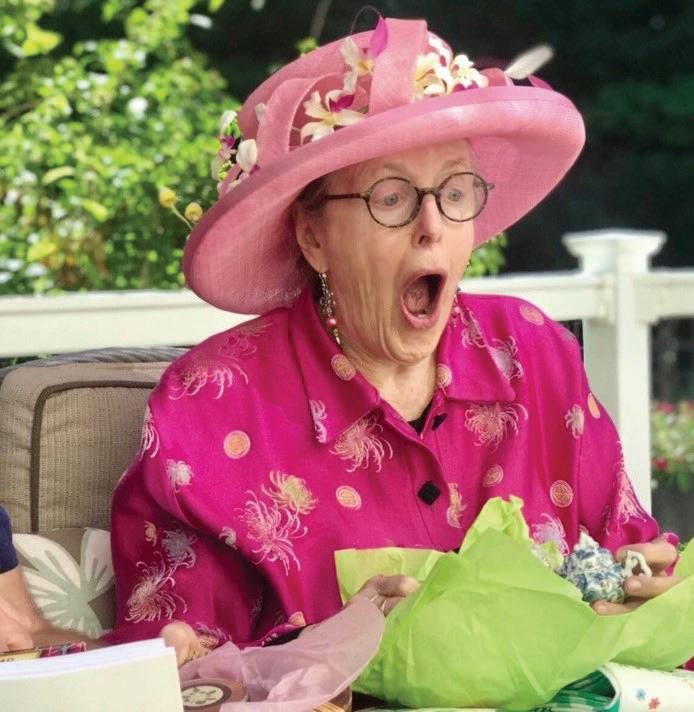
With her commanding presence, Shepherd was able to capture the room simply through the manner in which she spoke. Ben Smith, an English teacher who worked with Shepherd for 20 years, remembers her teaching style as engaging and one in which students had the opportunity to ri in a classroom setting.
“I taught across from her, (and) if you walked down the hallway past Mrs. Shepherd’s room, and a student was singing an aria from an opera, and someone else was doing a monologue, and students were hanging art all around, you’d be like, ‘Oh yeah, that’s Judith’s class,’” Smith said. “So my understanding of Judith as a teacher was (that) it was theater. It was about creative expression and really great, deep conversations.”
Smith remembers Shepherd as a conversationalist, both inside and outside the classroom.
She wanted real relationships with the people with whom she taught, he recalled, which made it easy to establish a rapport with her.
“Judith was so many things.
As a colleague and as a friend, she was someone who wanted to know about you. She would interview you — some might say interrogate you — for the details of your life, but it was because she just wanted to know you really well. It wasn’t just about the job (for her),” Smith said.
Due to her lengthy tenure at Conestoga, Shepherd was well respected by her colleagues, one reason for the collective effort to install a memorial in her memory. Smith recalls that she had institutional knowledge of the school from working in so many di erent positions and was a source for knowing how it operated.
“She was like our grand statesman of the English department; our matriarch. I once described her as part museum, in the sense that you could go to her to get a bit of culture but also as someone
who housed a lot of culture,” Smith said.
Shepherd’s in uence extended past the contours of her department, as well. Jon Koenig recounts how, as a newer teacher working in the Social Studies department, he o en took counsel from Shepherd. As a philosophy and ethics teacher, he admired her ability to entertain sporadic discussions in her classroom, which contrasted with the more structured format of other classes. Koenig believes Shepherd exuded a spirit of inquiry, integrating large questions into her teaching and bringing forth student voices.
“When you talked to Judith, you knew she was about the students. As a young teacher, I really admired that, especially from a person who’s done it a lot (and) who’s sharing their ideas with me,” Koenig said. “Frankly, for someone who was not in my department, I talked to Judith Shepherd more frequently than I would have (imagined). And I think it’s because we had similar interests in caring for those types of conversations in class.”
A group of Shepherd’s friends will install a memorial bench and plaque in her honor in the small courtyard directly under Room 250, her former classroom. Students in the life skills program will plant 175 tulip bulbs, her favorite ower, surrounding the memorial. Additionally, a group of Shepherd’s friends will hold a dedication commemorating her on Oct. 24 at 4 p.m. e program is currently set to include a cello performance, poetry recitation and words of remembrance.
Assessing assessment days
First period: math test.
Fourth period: submit history project. Seventh period: science quiz.
Multiple due dates, tests and quizzes falling on any given day was not unheard of for some students in years past.
Conestoga’s administration acknowledged that this created a stressful environment for students; thus, it implemented assessment days this semester with the goal of limiting student stress.

“Two, three, or even four tests on one particular day is challenging. We wanted to come up with a way to try to spread those tests out and lower some students’ stress,” school principal Dr. Amy Meisinger said.
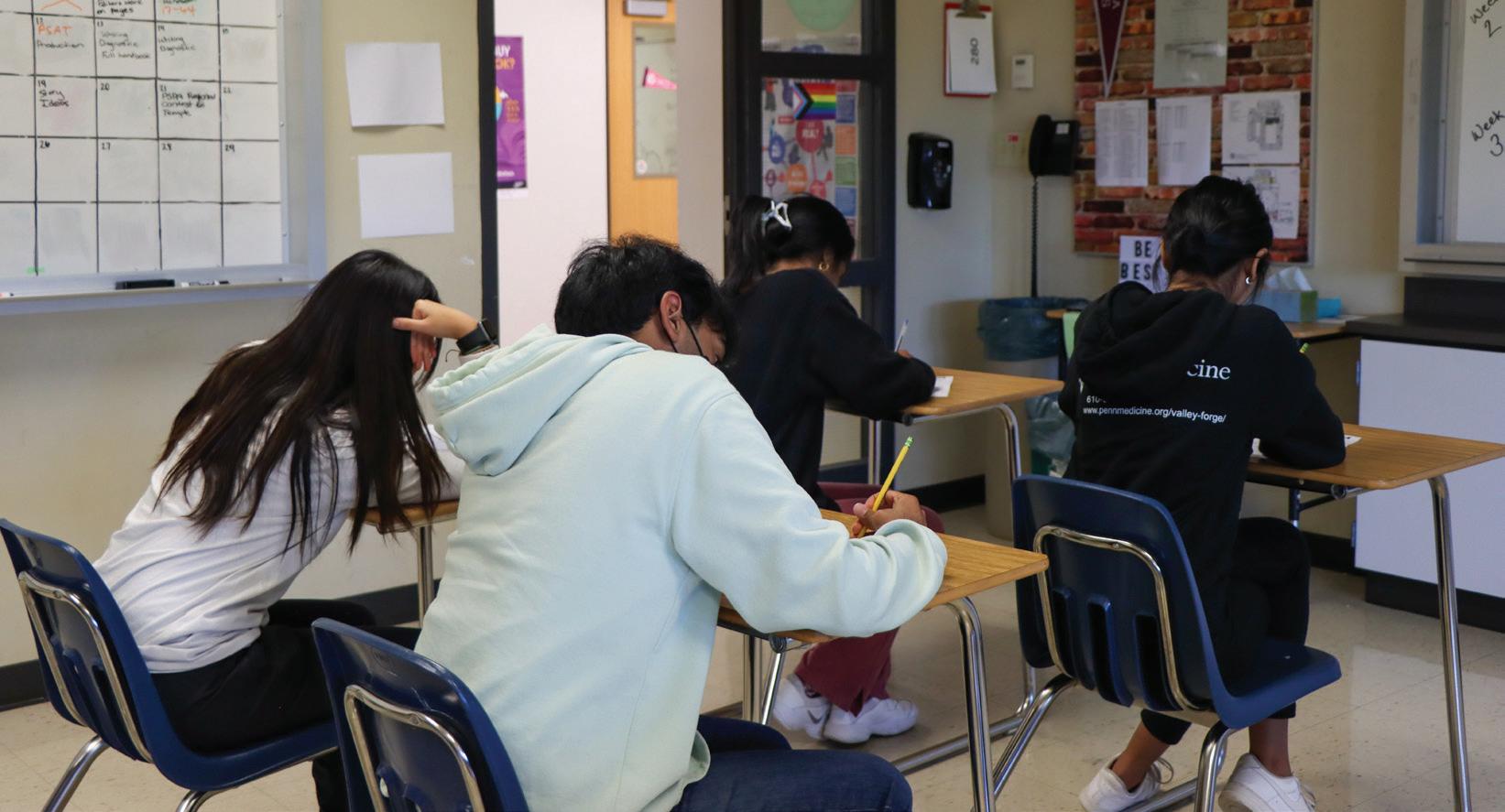
e addition of assessment days means that teachers must assign tests, quizzes that take longer than half of class time to complete and due dates for projects according to a school-wide schedule based on their respec-
tive subject area: World Language and English on Days One and Four, Math and Electives on Days Two and Five, and Social Studies and Science on Days ree and Six.
e e ect of assessment days varies among students. While some nd them bene cial, others dislike the change.
Sophomore Deekshitha Anandham has noticed that assessment days actually make her more stressed. For her, they have the opposite of the intended e ect; she now nds herself having multiple tests in a day, whereas before, her tests would have been naturally spaced out.
“I feel like it makes (me) a little bit more stressed. We have two subjects in one day, and that makes you have to study for two tests the day before. And, most people don’t plan out their studying,” Anandham said.
However, for junior Lex Shah, assessment days have made school easier.
“I like (assessment days) more than the old thing where I would have four tests on the
same day. I have them throughout the week so I can study for one thing the night before,” Shah said.
Teachers are a ected by assessment days, too. If their lesson plans do not align with their assessment day, they may have to move on to the next unit and wait to test on the previous unit for a few days.
Kathleen Walter, an AP teacher and Social Studies Department Chair, has not been greatly a ected by this change. Although she has had to move her lessons around, she did not nd it di cult to do so.
“ ere is a speci c date when the AP exam is going to be given if students choose to take it,” Walter said. “So, if unit one is nished and we’re not testing for two days, I’ll move on to unit two because we don’t have the leeway to just do some extra activities.”
Assessment days are still in their trial period and according to Meisinger, the administration will work to collect feedback on how they can be improved.


Revised Code of Conduct for 2022-2023 school year
Last year, the consequence for cutting class was a 10% grade reduction and two Evening Supervised Studies, a two-hour detention a er school. is year, the consequence is two weeks without free periods.
Conestoga’s administrative team revised the Code of Conduct for the 2022-2023 school year and set new expectations for student behavior, from dress code to disciplinary infractions.
Assistant principal Dr. Patrick Boyle explained that the administration made these changes because of comments they heard about class cuts and free periods from several teachers and students last year.
“ e input that students provide to us carries a lot of weight with us as administrators because it’s a collaborative model,” Boyle said. “We take input from everyone, including students, and several of them felt that the changes we made this year were needed.”
e new Code of Conduct states, “Students are required to dress in such a way that their stomach, midri and buttocks are covered and not exposed.”
Assistant principal Jamie Bankert a rms that the intentions for the dress code’s revisions were to return the school to its pre-pandemic norms.
“ ere was a certain level of exibility (due to the COVID-19 pandemic), so there were some atypical exceptions (with the dress code),” Bankert said. “ e changes to the dress code are not entirely new; we are just returning to what the building was like in the fall of 2019.”
Sophomore Mariel Hadjiliadas disapproves of the dress code because she feels that it limits her ability to express herself.
“I feel like (the changes with the dress code) were unnecessary,” Hadjiliadis said. “Students are being limited in their expression because the administration is limiting what we can wear. ey are targeting students who dress femininely when that’s just part of their style. It’s terrible.”
Additionally, the administrative team made adjustments to how students can enjoy their free periods. To ensure that every student is accounted for throughout the day, when students are not assigned to a class, they must go to the atrium, library or cafeteria.

At each of these rooms, students must sign in so the administration has a log of where everyone is at any given time. In the cafeteria and library, students sign in with a Microso Form on iPads located at the entrance of the room; in the atrium, a sta member stands at the entrance and scans students’ IDs as they enter.
Merri Gardner, a U.S. Government and AP U.S. History teacher, believes that the new sign-in procedures for free periods are important for student safety. Acknowledging that some students may not like the new policy, she reasons that the bene ts outweigh the potential drawbacks.
“What kids don’t understand is our number one job is not to teach you history or chemistry; it is to keep you safe. If we don’t know where you are, we cannot do that,” Gardner said.
Despite some students’ negative opinions on the new school policies, Boyle feels that the changes to the Code of Conduct were reasonable because, at the end of the day, students are responsible for their own actions.
“Our kids have more responsibility. For example, what schools let them go out for lunch? What schools o er free periods instead of study halls? What schools allow students to have the ability to earn a privilege other than here?” Boyle said. “Our students are responsible young men, women and people who can handle the responsibility that comes with the privileges.”
School lunch program expires, breakfast program unveiled
 Tanisha Agrawal Sta Reporter
Tanisha Agrawal Sta Reporter
As a new school year ramps up, some students are trying to adjust to what had been a key part of their day last year: free school breakfast and lunch, regardless of their household’s income.
On June 30, the federal Universal School Lunch Act, a program that provided all students with free meals during the COVID-19 pandemic, expired, leaving millions of families scrambling to apply for other available programs. Some looked to the National School Lunch Program, which provides balanced, low-cost meals to children in need.

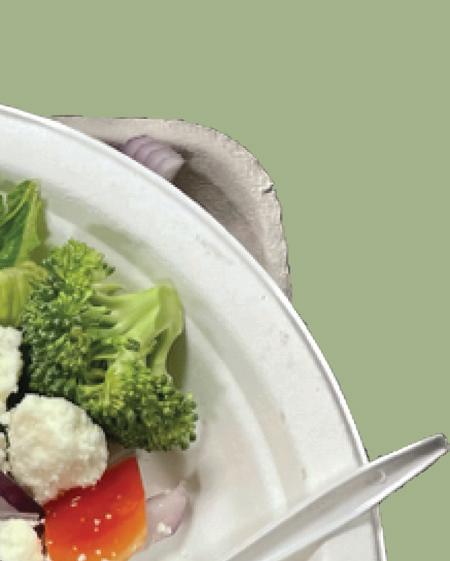

Families earning less than 130% of the federal poverty line can apply for free school lunches. Families earning 130-185% of the
poverty line can apply for reduced lunch. Currently, the federal poverty line for a household of four is an annual income of $26,500 or less. However, those who barely miss the criteria are back to paying full, pre-pandemic prices. At T/E schools, this is $2.75-3.75 for breakfast and $4-5.25 for lunch.


“I feel bad for the kids that cannot a ord to pay. I wish that everybody could eat for free. If I had it my way that’s how it would be,” said Louise Gardener, a cafeteria worker at Conestoga.
Families who barely miss the quali cations for free meals by federal programs have other options within the school district.

T/E’s School Meal Assistance Program, for example, delivers a set amount of money to a student’s lunch account and is relled upon request.

“If T/E o ers free or reduced lunch to someone, we promise to keep it con dential. Nobody except the administration has access to how much a student pays.
Twenty years ago everyone had color-coded tickets, which led to discrimination, and we stand against that now,” said David Preston, the T/E food and nutrition department supervisor.
In September, Pennsylvania Governor Tom Wolf unveiled the Universal Free Breakfast Program, set to serve 1.7 million students free breakfast. Even though many applauded this initiative, it is essential to note that it only accommodates school breakfasts. Additionally, the program is set to expire in 2023, prone to reopen the debate on free versus paid meals for all public school students.
2 ursday, October 20, 2022News A BRIEF LOOK THE LATEST DEVELOPMENTS IN T/E AND NATIONAL NEWS
Shrija Krishnan Sta Reporter
Soumya Sathyanarayana Co-Webmaster
Aashita Singh Sta Reporter
Fashion icon: Former English teacher Judith Shepherd’s colleagues and students remember her unique sense of style. She would o en show up to school and public events wearing extravagant hats, scarves and jewelry.
Courtesy Ben Smith
Heading out: Senior Aaron Sun signs out of school during eigth period. The new Code of Conduct laid out the responsibilities that come with having free periods.
George Zhang/The SPOKE
Taking tests: Students complete an assessment during their class’ assigned assessment day. The administration implemented assessment days this year with the intent of decreasing their stress.
George Zhang/The SPOKE
Photo
Illustration by Tanisha Agrawal and Aren Framil/The SPOKE
Read
more at
T/E LIFE
NEWS Conestoga’s chapter of Tri-M Music Honor Society hosted an induction for new members of the organization on Sept. 28. Entrance into the group is extended to students who have shown excellence in the music department. Administrators Dr. Nicole Jolly, Nathan Shughart, Christopher Nation, Cassandra Hesse and Dr. Amy Meisinger shared remarks about the obligations and quali cations of Tri-M members, as well as the accomplishments of the inductees to be welcomed into the group. The Conestoga girls varsity soccer team beat Downingtown West 4-1 on Monday, Oct. 10. West took the lead in the beginning of the game, but Tory Gauthier evened the score 1-1 by scoring a goal shortly a er. From sparkly mini-dresses to owy monochrome, students brought a variety of looks to this year’s Hollywood-themed Homecoming. Some upperclassmen didn’t attend the dance, but decided to dress up for the occasion as well. Girls soccer comes out victorious against Downingtown West
SPORTS
Hollywood Homecoming
Tri-M Music Honor Society inducts
new
student members
The girls’ volleyball team played Penncrest on Monday, Oct. 10 in the large gym as their Dig Pink game fundraiser, where they sold baked goods to support cancer research. Penncrest had an early lead, but ’Stoga came from behind and took the rst set 25-22. Penncrest tied the score by winning the second set 25-17 a er maintaining a steady point margin throughout the game. Girls varsity volleyball loses to Penncrest 3-1
Increasing student population: Conestoga’s decades-long trend

Increasing population’s effect on property values
Continued from page 1. for moving from a nearby school district to TESD was simple: the quality of education. Wang believes that when people who prioritize education constantly move to the same school district, it creates a “positive loop” for school outcomes and standardized test scores, both of which a ect rankings.
When comparing school districts state-wide, academic rankings typically favor Conestoga, according to U.S. News and Niche. Realtor Susy Shea, who works primarily in the T/E School District, has noticed that, historically, this area attracts a lot of relocation buyers.
roughout her 22 years of experience, Shea has worked with many clients who don’t mind longer commutes to work and Conestoga alumni who return to the area to raise their children.
“We have people out here (that) work in the city, who want to be out here with the great schools, and they don’t mind that commute into the city,” Shea said.
“I’ve had a bunch of clients recently, where they go to Conestoga, and then they’d go to college for a while and then come back and want their kids to go to ’Stoga. It’s a really strong pull, the Conestoga alumni legacy.”
Not only do some alumni move back to the district because of its academic prowess, others looking to provide their children with a good education do so as well. Silpa Nair moved her family here in early 2020 mainly because of just that: the district’s education standard.
“I have friends and colleagues who have kids (in) the school district, and I have always heard great things about the teachers and resources available,” Nair said. “Education is a base that is necessary for the kids. It’s not about excelling in their academics, but instead about (providing) an environment where they feel like they can grow.”
Likewise, for freshman Jeffrey Wang’s family, their reason
Chester County has also seen an increase in townhomes throughout the areas of Wayne Glen and Village Square. In 2021, the median price of homes within the county was $420,000. In stark contrast, the townships of Tredy rin and Easttown have some of the highest median sale prices of $850,000.
Tredy rin Township Director of Planning Erin McPherson credits this upward trend to the increased demand for property.
“T/E School District in general is highly regarded; when people are looking for homes, they want to be within a good school district, so that becomes a primary focus of many people. When you have a good school district, it can drive up the cost of homes because it’s highly desirable,” McPherson said.
Despite some price uctuation in TESD, Shea maintains that property values here have generally remained steady, even when “prices were tanking everywhere,” such as during the 2008 housing crisis. According to Shea, when compared with the rest of the country, the price drops in Tredy rin and Easttown townships were insignicant. She notes that low tax rates and high property values make this area attractive to buyers.
“Here, we have one of the best school districts in the state, yet our taxes are quite low. Right now, we have a huge number of buyers who want to buy immediately,” Shea said. “Say you have
10 o ers on the house you’re selling; one person gets the house and now nine buyers are still out there looking. Because of that demand, buyers are still willing to pay a good price.”

Conestoga’s accommodations for increased enrollment


Increased enrollment at Conestoga has created the need for physical additions to the school building — from Conestoga’s first expansion to include more classrooms in 1966 to
the addition of the atrium and new wing in 2021. According to Kantorczyk, the 2021 expansion was the direct result of the projected increase in enrollment rates.
“The most tangible way (enrollment has affected our school) was a decision to put an addition on the high school and also to reconfigure other parts of the building. We look at what the availability is in the building, what space is available, and what our projected enrollment looks like, and do
an evaluation as to whether we’re going to be able to maintain the status quo,” Kantorczyk said. “What was happening at the high school looked like it was getting into a red zone, so we made a decision to add on to the high school.”
Although enrollment has been steadily increasing, the number of students in each classroom has not. Assistant Principal Patrick Boyle noted that the hiring process for teachers was relatively seamless this summer, with Conestoga
receiving multiple applications for open positions.
“We were lucky this year in being able to make decisions and hire the best teachers for these positions, whereas other school districts didn’t have that (luxury),” Boyle said.
Conestoga continues to accommodate the rising number of students in a multitude of ways, including expanding the building and adding new classes and clubs. Boyle and other administrators work to meet the needs of the ever-increasing student population.
“It’s been a concerted e ort across all avenues within the building to meet the needs of increased enrollment,” Boyle said. “We monitor the enrollment, look at where the trends are going academically, we look at where the needs are for those students and continue to support them moving forward. It’s not something where we sit there and say, ‘We’re gonna wait and see what happens.’ We try to predict, as we do right now, where the enrollment is going to be so we can plan accordingly.”
Studying for a spot: Allied Health program experiences greater competition
best in the class in order to get it,” said Michael Levin, a senior enrolled in Allied Health.
When then-juniors applied for Allied Health last spring, they pictured themselves getting an exclusive peek at a hospital behind closed doors.
e program, according to the Program of Studies, “exposes academically talented students to the numerous health careers available today.” It also promises a combination of in-person clinical and classroom experience to prepare students for future careers in the healthcare industry. For many, however, that narrative quickly shi ed when they began classes this September.
“Now, it seems like maybe I’m not guaranteed what I signed up for, which was 7.5 hours per week of clinical rotations. ey still promote that in the program like we are going to do it, but it seems like you have to be the
In years past, every student was guaranteed hospital experience for clinical rotations. Now, the program will only take the top 10 scorers on program-speci c tests out of the 17 enrolled students. Allied Health clinical rotations are o ered at the Phoenixville and Paoli Hospitals, but the competition is only occurring at the Phoenixville location due to a lack of available spots for students in the hospital.
“With more students looking to go into Allied Health professions when they nish high school and start their college careers, spots become limited,” said Florence Batton, an Allied Health teacher. “ is is also seen at the college level: as more students apply for Allied Health professions, their acceptance process becomes more competitive.”
Optional” doesn’t *really* mean that...
From October 3-15, the top students got to participate in clinical rotations. Before then, all 17 students had to be in the classroom every morning at 7:30 at the Technical College High School Pickering Campus. Once the top 10 students moved to the hospital, the remaining seven had to sign on to watch the rotations virtually, through Zoom.
Senior Chaitanya Krishna joined Allied Health a er hearing positive reviews from friends who participated in the program in years past. When he learned of this year’s competitiveness, he was worried about the increased stress it could cause him.
“I was a bit concerned because basically everything mattered,” Krishna said. “You have to be on top of everything, every day, and you can’t come late or you will lose clinical days. I guess
it’s preparing us in a way for how the real medical eld will be.”
Lucky for students, the initial “top group” is not permanent. Students will be able to cycle through clinical experience if they get their grades up and demonstrate a commitment to the course through attendance and punctuality. Although competition has been an unexpected barrier for many students, it has also become a motivator to work hard and get the best grades possible.
“If people want to do (Allied Health), they should know that it’s going to be tough and take up a lot of time. But if you’re really interested, you shouldn’t shy away from it because it’s too competitive. I think there will always be a way,” Krishna said.
“She (Ms. Batten) says if you put in the e ort and you’re a good student, she’ll make sure you do get clinical days.”
3ursday, October 20, 2022 News
Julia Harris Sta Reporter
Poring over pages: Senior Natalie Haracz, an Allied Health student at the Phoenixville location, studies her textbook for the program. She had an upcoming test on common medical terminology.
Julia Harris/The SPOKE
“Test
Like a super-secret handshake to get in the door, competitive colleges really do want to see test scores, they just won’t tell you that. Grades alone aren’t going to get you there, so it’s time to think about doing your best on the SAT or ACT. Find out more at CrimsonReview.com.
Freshman claims title at national Pokémon tournament
In 2017, freshman Christopher Han picked up a video-game controller and tried playing Pokémon Sword and Shield. He didn’t think much of it — a er all, it was just a bunch of characters battling on a screen. But as he played more, he began to take a casual interest in the game. Little did he know that ve years later, he would claim a lot of fame from ranking rst in an international Pokémon tournament.
“When I won, I was like, ‘I don’t know what to do from here. I just made the grand nals. I am going to be on live-stream,’” Han said. “I was just shocked that I actually won.” is past June, Han competed and ranked rst in the Pokémon North American International Championships. Forty-three players competed against one another
in Columbus, Ohio. ey played two rounds of elimination in the video game Pokémon Sword and Shield, and their goal was to reach a certain threshold of points to proceed to the Pokémon World Championships. Han, competing in the Senior Division, received 500 points, more than double the required minimum of 200. He also competed and ranked 16th in the world tournament, making him the rst in the local area to achieve such a feat. His success, however, was accompanied by some struggle.
When Han entered sixth grade, his father signed him up for the North American tournament for the rst time. He had just began playing Pokémon Sword and Shield but decided to enter the competition to challenge his skills.
“I didn’t do as well as I hoped in the tournament, but I still really
enjoyed playing in it,” Han said. “I decided that this is something I wanted to do and be pro cient at.”
For the next year, he continued to practice and develop his skills to ensure that he was well-prepared for the next interregional tournament in 2020. at is, until the COVID-19 pandemic hit.
“I was forced to play online for two years, which was denitely a di erent experience,” Han said. “ ey (the tournaments) were a lot more boring. I realized that the atmosphere of playing in-person and getting to see competitors de nitely makes the tournaments a lot more fun.”
Despite this two-year hiatus, Han continued to practice until the next in-person tournament. When COVID-19 restrictions receded in 2022, he made a rm decision to compete in the national tournament. He spent close to two
hours everyday for one year playing Pokémon Sword and Shield. And, on June 12, Han competed in his rst interregional tournament a er three years.

“I went into the tournament thinking that I would do well, but (not) win,” Han said. “And I wasn’t con dent in how I was playing.”
Looking back, Han appreciated the many bene ts that came from the tournament. Besides gaining new skills, he met new peers with the same interests and received a large cash prize. He was also able to advance to the world championship in August 2022 in London.
In the future, Han plans on using the money he received from this past tournament to compete in San Diego and Orlando, and a few international tournaments in Europe and Oceania. He also hopes to participate in the world tournament next year.
CHESTER COUNTY
COLOR 5K
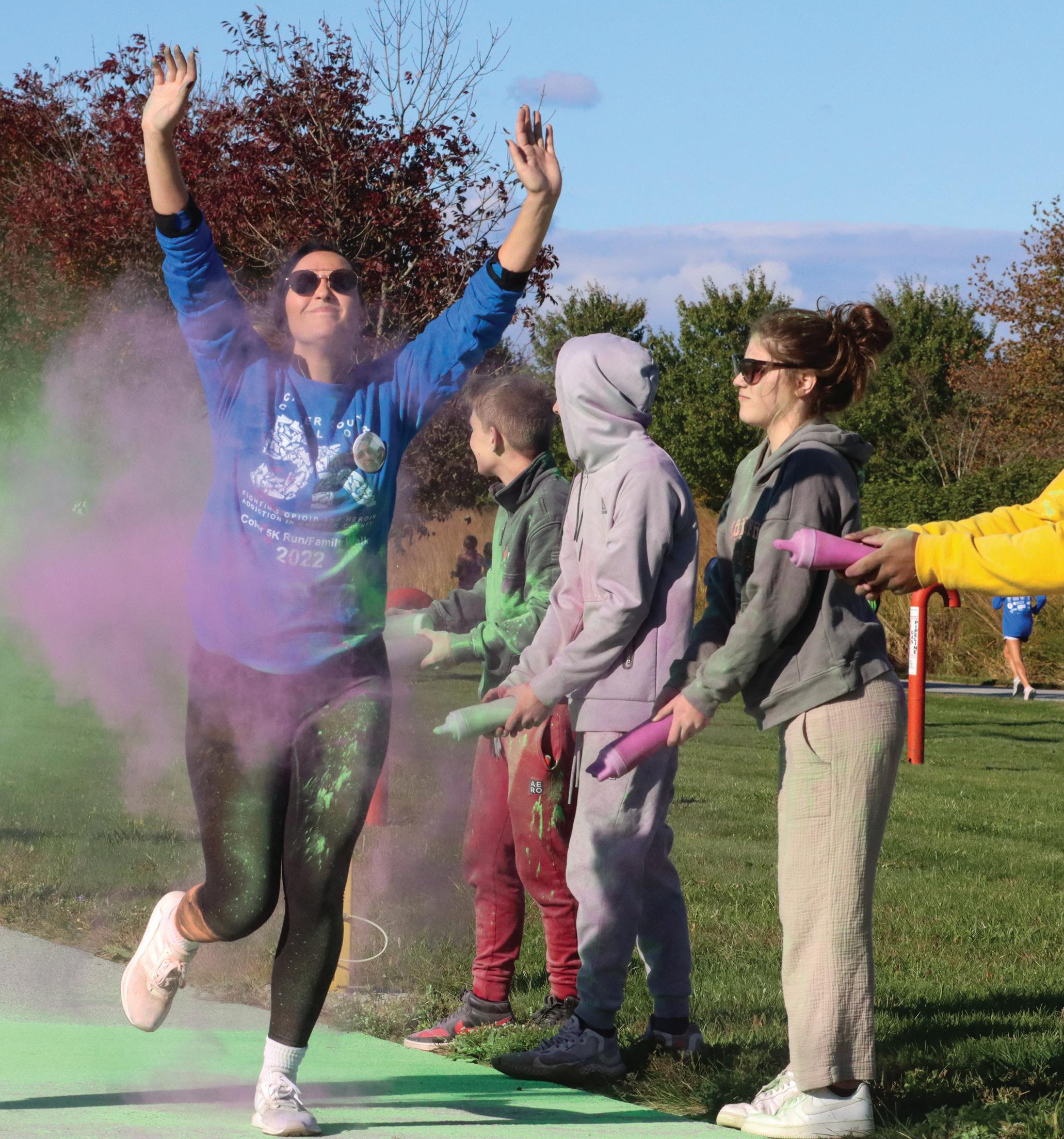 WRITTEN BY AREN FRAMIL, CO-DESIGN EDITOR
WRITTEN BY AREN FRAMIL, CO-DESIGN EDITOR
Runners lined up at the starting point of the Chester County Color 5k on the morning of Oct. 8, waiting for the countdown. Ready... set... go! The racers set off down the Chester Valley Trail, volunteers on the sidelines spraying colorful powder onto them from all directions. Beyond a celebration of health and happiness, this vibrant display has an important purpose: raising money and bringing awareness to the Chester County opioid and heroin epidemic.
The Color 5k is an annual run that seeks to raise money for the Community Outreach Prevention and Education (COPE) Program, one of many initiatives instated by the Chester County Department of Drug and Alcohol Services to combat the opioid crisis. Runners and walkers alike are welcome to partake in the Color 5k, and many participants run in memory of friends and family members they have lost to addiction and overdose.
County Commissioner Michelle Kichline began the run six years after discovering a widespread epidemic through the community.


“Through talking to a lot of people I realized that there were a lot of families and people of different ages suffering (from an) addiction crisis, or had lost people to addiction and overdose,” Kichline said.
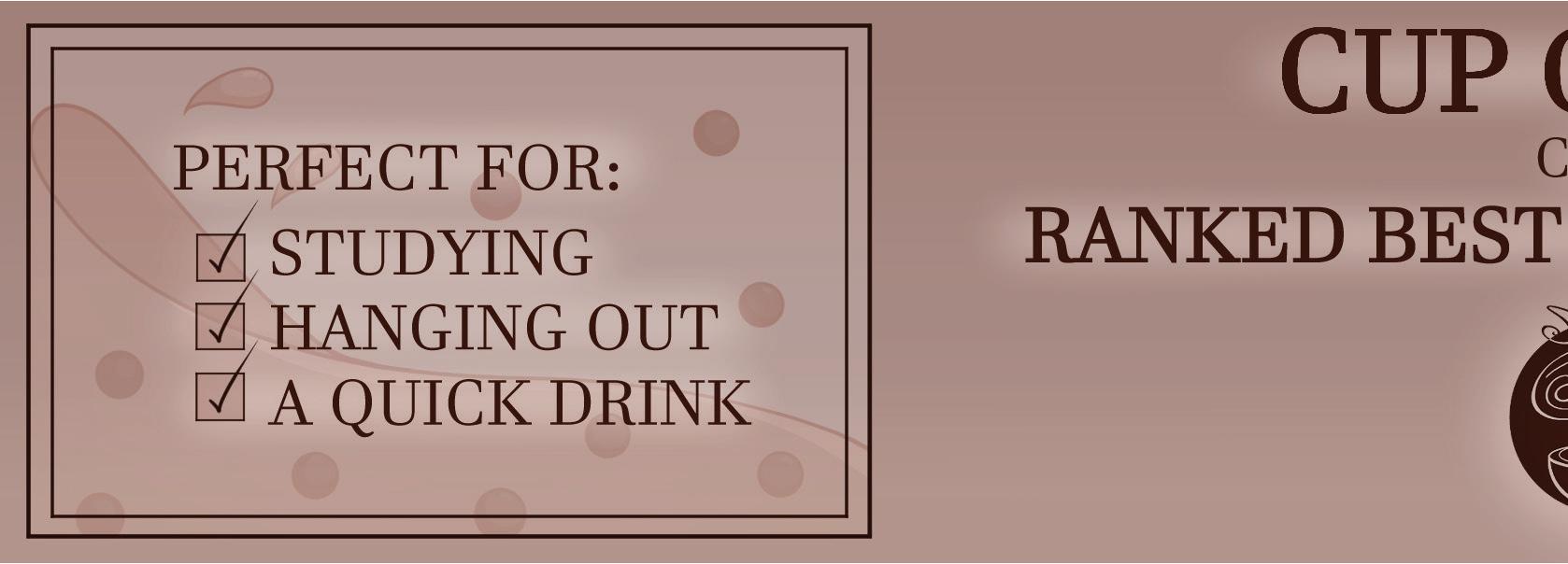
“At the time I started, six or seven years ago, there (were) a lot of prescription opioids out there, and people were really misusing them.”
Then Kichline came across the COPE Program, an initiative that assists individuals who have suffered an opioid overdose. Instituted in every hospital in Chester County, the COPE Program provides certified recovery specialists to overdose survivors and their families, working to find the best treatment for each individual.

Beyond the COPE Program, the Department of Drug and Alcohol Services has numerous initiatives working to prevent addiction and overdose, and provide rehabilitation services to those who need it. To minimize the risk of addiction and overdose, the Department has placed drop boxes for medication, distributed Narcan, a medication that can reverse opioid
overdose, and hosted events such as Night of Light.
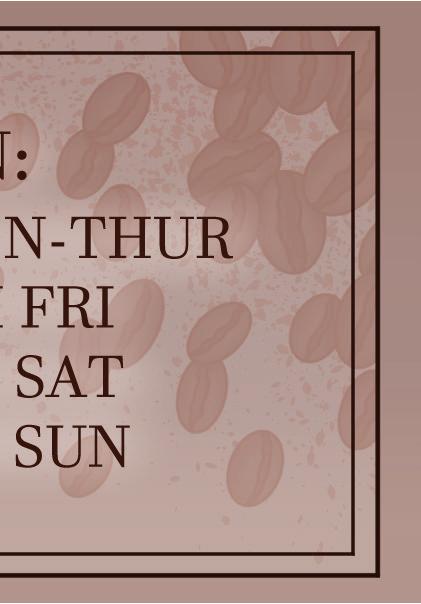
“We do a lot around public awareness. We go out and do speaking engagements, presentations to schools and churches. There’s a lot of handout materials that we send out. Also, part of what we’ve always done as part of my department is provide treatment services. And that’s not specifically for opioids, it’s for any substance, but of course, opioids over the last few years has become a primary drug,” said Vincent Brown, Executive Director of the Department of Drug and Alcohol Services.
The importance of these programs is felt the most by those who have lost a loved one to overdose. Jeanne Hill and her family commemorate the 10 year anniversary of the loss of her 29-year-old son Branden by attending the Color 5k and with their “Forever Hill” shirts.
“As far as addiction programs (go), 10 years ago, there weren’t things in place for help,” Hill said. “I mean, you can get Narcan easily nowadays, there’s addiction programs in place and the help is there. You just have to reach out.”
they
Zara Samdani Copy Editor
Master Trainer: Freshman Christopher Han battles at the Pokémon North American International Championships. The tournament took place in June and he was able to place rst and win a cash prize.
Courtesy Christopher Han
Aren Framil/The SPOKE
Running with purpose: Jeanne Hill (right) stands with her family.
They
participated in the Color 5K in honor of Jeanne’s son, Branden,
who
lost to drug overdose 10 years ago. T/E LIFE ursday, October 20, 2022
Racing through the colors: A partcipant in the Chester County Color 5K runs as volunteers spray colored powder at her. The race took place on Saturday Oct. 8 and involved many members of the community.
Add some color: A runner is doused with colored powder while participating in the Color 5K. Participants were covered in shades of blue, orange, green and purple.
George Zhang/The SPOKE
George Zhang/The SPOKE
Sunlit spaces, lush greenery and rustic decor – all key components of the popular Terrain Cafe in Devon.


The cafe is a part of the garden and home goods store known as Terrain, which blends nature with modern furnishing trends and styles. Nestled in one of the location’s greenhouses, the cafe offers indoor and outdoor dining in a uniquely botanical atmosphere. A soft blend of natural and LED lighting creates an elegant ambience. The space certainly sets the tone for a relaxing dining experience.
To start, the menu offers a popular Artisanal Cheese Board, featuring locally sourced cheeses as well as pickles, fresh berries, fruit preserves, crostini and honey. This generously portioned appetizer was reasonably priced at $19 and could easily be shared amongst a table of four or five. The selection of cheese was nicely diversified, varying
Homecoming happenings: Classic high school tradition returns
Madeline Pulliam Sta Reporter
Lights, camera, action! Students walked the balloon-lined red carpet into this year’s Hollywood-themed Homecoming dance.

The dance was held on Saturday, Sept. 24 following the pep rally, spirit week and Homecoming football game on Sept. 23. The pep rally, where students could participate in multiple activities such as a field goal kick and relay race, was held on Teamer Field the day before the dance. The senior class won this year, with freshmen coming in second and juniors and sophomores tying for last place. Teachers could also participate in the pie-eating contest, which was not allowed last year due to COVID-19 guidelines.
“My favorite part to plan is the pep rally and the rest of the week leading up to Homecoming with all of the spirit
days. It was also really fun to set up all of the decorations beforehand and prepare the DJ,” said Daniel Tu, the school executive president.
Last year, the Homecoming dance was pushed to April 23 to avoid COVID-19 restrictions that made the dance nearly impossible to host. The spring dance also allowed students to attend without masks because of the eased restrictions. There was no food or drinks other than cups of water, and there was no theme to the dance.


“More people came to this year’s dance than last (year’s) because last year there was still COVID going on. But other than (COVID-19 restrictions), it was pretty much the same as our regular year,” Tu said, regarding the changes from last year’s dance to this year’s.
This year, student council members planned the Hollywood theme. The main
entrance of the school had streamers, and TETV interviewed guests upon entry. The timing of the dance was also different from pre-COVID years to allow students to leave earlier. Before COVID-19, the dance was from 8–10 p.m., while this year, the dance was from 6–9 p.m. Attendees could buy soft pretzels, tomato pie and cookies between the gyms and help themselves to cups of water available near the gym entrance. Students were also able to eat and hang out in an enclosed area outside the gyms to get away from the loud, warm dance floor.
“I thought the dance was really fun, and I really liked the decorations and the theme,” said freshman, Arush Patel. “My favorite part was definitely hanging out with my friends and dancing.”
Many sophomores, juniors and seniors did not attend, but instead dressed up and took pictures with their friends or
went out to dinner together. The upperclassmen are more focused on the upcoming junior and senior proms later in the year according to sophomore Tanvi Bommisetti.
“I didn’t go because even though prom is still a year away for me, I am way more excited for (prom),” Bommisetti said. “I think many seniors and juniors also didn’t go because they know they also have prom to look forward to.”
Many of those who did attend viewed the dance as a right of passage for high school students and a classic tradition that all high schools share. They are also ready for events to return to normal and to have a traditional high school experience.
“I think it’s just a high school thing that everyone should experience,” freshman Delisha Makdani said. “Most of my friends think the same thing as well.”
:Terrain Cafe
accordingly in texture and flavor. The sweetness of the honey and fruits balanced the sharpness of the harder table cheeses. A small portion of mustard seed was included, which complimented the milder gouda cheese. The pickles, having been prepared in-house, had a lovely flavor.
e Blistered Shishito Peppers, also o ered as a starter, were highly underwhelming. e dish was simply a pile of small, cooked green peppers. Lacking in added seasoning, the peppers themselves were unfortunately quite mild, leaving little to justify the placement of roughly 20 on the serving plate for a poorly spent $7.
e Terrain Burger, one of the cafe’s staple entrees, o ers a nice twist on this classic meal. It’s prepared with cheddar, dressed greens and a balsamic onion jam, which o ered notes of sweetness along with the savory onions. e burger rings up at $18 – a he y price tag for a relatively simple dish.
However, with restaurant prices rising nationally and a large

serving size, this price was somewhat expected. e dish can be served with a side of regular fries for an extra $2 or trufe pecorino for $4. e tru e pecorino fries were worth the $2 upcharge from the regular, with avors of the tru e and pecorino cheese complementing each other nicely.
Overall, Terrain is a nice spot for those looking to enjoy a farmto-table experience in a beautiful atmosphere. e quality of the food itself is truly dependent on the order, and he y prices make some choices riskier than others. However, the unique decor and fresh, locally-sourced ingredients make Terrain a worthy experience for a night out.
Terrain Cafe 138 W Lancaster Ave Suite 120 Devon, PA 19333 Price: $$ Rating: Phone: 610-590-4675

Hours: Monday- ursday: 11 a.m. - 8 p.m. Friday-Saturday: 9 a.m. - 9 p.m. Sunday: 9 a.m. - 8 p.m.


 Abby Bagby T/E
Abby Bagby T/E
Life
Editor
Aesthetic atmosphere: Terrain Cafe’s greenhouse dining space is so ly lit to create an elegant atmosphere.
T/E Lifeursday, October 20, 2022 5 The little things: Terrain is known to serve its drinks in Mason jars as a nod to its rustic design style. Tables are decorated with small, seasonal arrangements — currently pumpkins and votive
candles.
The night is young: Freshmen Danielle Douglas (right) and Toscane Franchet (le ) pose for a photo upon entering the gymnasium for this year’s Homecoming dance.
Dance the night away: Students pair up for a special partner dance at the Hollywood themed event.
Hit the dance oor: Students gather on the gynasium oor during the annual Homecoming dance. As with any classic high school dance, mosh pits and dance circles were formed repeatedly throughout the night.
Abby Bagby/The SPOKE
Abby Bagby/The SPOKE
Lily Chen/The SPOKE
Lily Chen/The SPOKE
Lily Chen/The SPOKE
Written by Jui Bhatia and Raima Saha, Manag ing Editor and Co-Design DEditor esigned by Raima Saha, Co-Design Editor
FANTASY
With a bachelor’s in communica tions and a minor in business, Lau ra Howard, Conestoga’s new English teacher and Spoke adviser did not fore see this career path until later in her life.






Her undergraduate education natural ly led her to a career in public relations and marketing, and she earned her MBA while working full time at a small agen cy in Wayne. She then switched over to work for Comcast because she wanted more out of her career. Even with that switch, however, Howard felt unfulfilled.
“I was feeling unsatisfied, but I wasn’t sure why. I did enough, but I just felt like I had more to give back to the world, as cheesy as that sounds,” How ard said. “So I shadowed my mom, who was a teacher for 30 years, and I fell in love with teaching.”

For Howard, it all fell into place from there. She went back to school

Growing up, Ryan Howard felt like he was always meant to teach. Originally a business major, Howard decided to make the switch during grad uate school and get a master’s degree in education, inspired by his teachers and passion for working with others.


“I had inklings,” Howard said. “I remember working as a camp counselor in the sum mer, and when I was in high school, I really enjoyed coaching the kids and working with them, and I always had really good connections with my teachers.”
Having been a social studies teacher for 16 years, Howard’s fa













vorite part of teaching is watching the impact he has on his students.
“I just really love watching kids grow and blossom and develop into great people. I’ve been do ing this long enough that some of my first students now are adults and have children and families of their own and have even become friends (with them),” Howard said.
Howard is also an avid football fan. He enjoys playing fantasy football and is an assistant football coach on the school team. Coaching for 18 years, he is passionate about sharing his love of football with others. In his spare time, he loves spending time with his two daughters. He says watching them discover themselves inspires him.



“I love hanging out with (my daugh ters) the most,” Howard said. “We like to do art and play sports together.”


Howard is also inspired to form connections with his stu dents. He believes that they can enhance the content he teach es and help his students’ future.

“I think that every teacher has an impact on every student, and that (impact) can be positive or negative,” Howard said. “So I do my best every day to make a positive impact and not just teach concepts (but also) life lessons and (developing skills) that are going to carry them throughout the rest of their lives. I really like to see my students grow into better people, not just better students.”
to get another master’s in education. As for what she would teach, the choice was simple.

“I’ve always loved English. I’ve always read novels in my spare time for fun,” Howard said. “I should have known that the signs were pointing (toward) English teacher.”
Other than reading, Howard enjoys spend ing time with her family, which includes playing with and chasing after her two young boys who attend Beaumont Elemen tary School. She also enjoys binge-watching a good show and going to the movie theater.
“I love to play games and be out side with them and get as much fami ly time as I can soak in,” Howard said.
“My biggest hobby personally is read ing, and I’ve read 56 books this year.”
As for what motivates her every day, Howard considers herself a so cial person who enjoys spending time with teeenagers and emphasizes the importance of enjoying what you do.
“I love being around teenagers and interacting with them and just seeing their perspective on the world.” Howard said. “The most important thing is that you have to like your students, or the age group that you’re teach ing, more than the curriculum.”
Howard feels one of the most rewarding things about her job is seeing teenagers grow.
“My favorite (part of the job) is when I see kids directing their own learning and finding their own passions, and taking the things we learn about and applying them to real life,” Howard said. “I want to help make the world a better place by producing better and more conscious citizens. I want to provide a place where (students) feel comfortable enough to share and express their opinions.”
Junior lands software design internship, codes key features of iOS app
Junior Rhea Malik designed Matter’s two most important features this summer as their youngest and only intern. It all started when she cold-emailed more than 75 software com panies to ask for an internship — most declined, either stating that there were no free positions or that she was too young. Still, Malik persevered and finally scored an internship at Matter, a startup company based in San Francisco, California.
The company’s main prod uct is their app known as “Mat ter: A better reading app” that lets users pull articles and ma terials such as tweets, podcasts and newsletters from the web
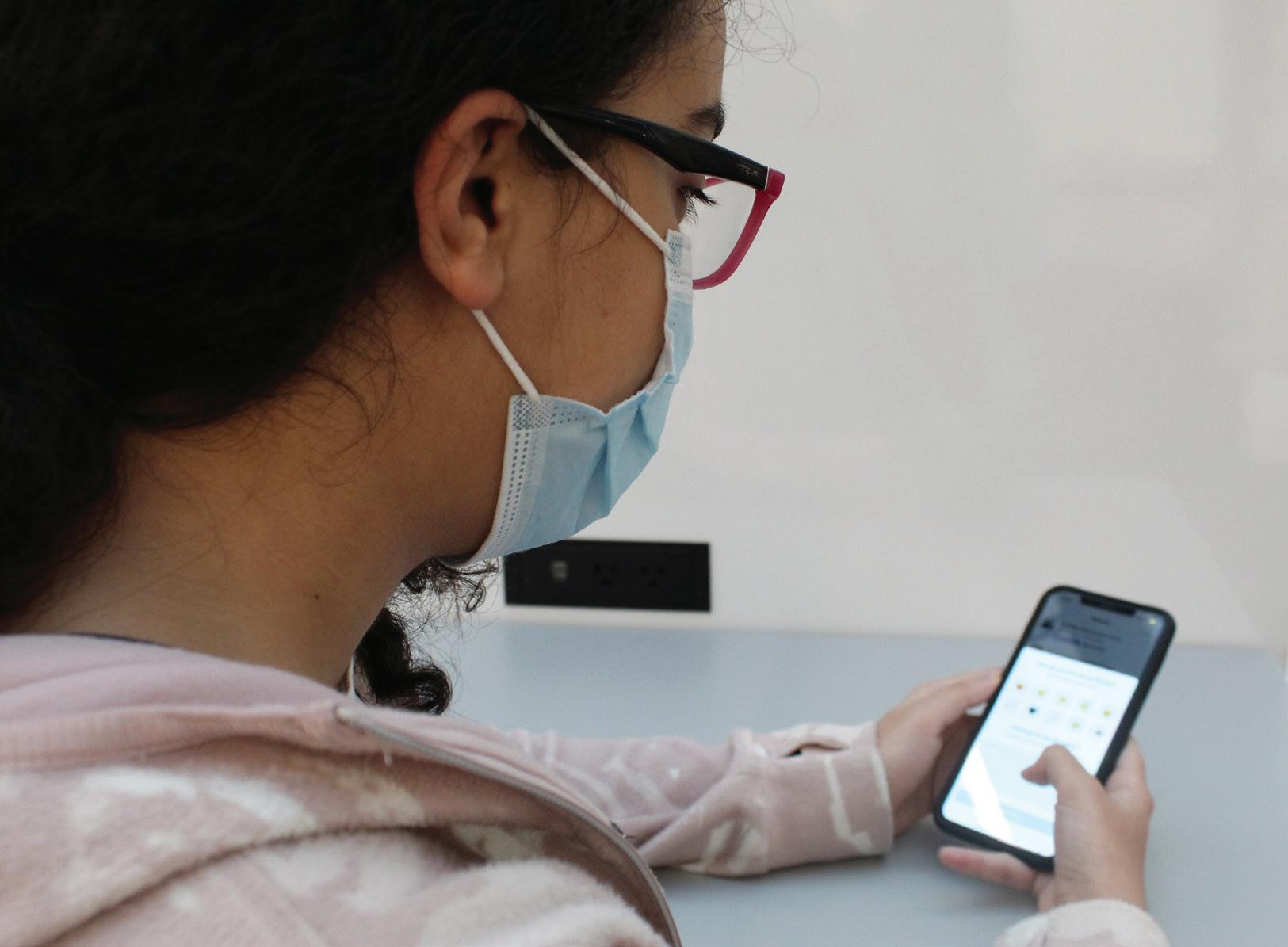
and organize them within a personalized content library. From there, users can read, an notate and listen with their hu man-sounding AI.
Malik discovered Matter by searching for small companies and iOS apps that she wanted to develop. At first, Matter did not plan on hiring an intern, but after receiving a robust cold email, they decided to take her in.
“We didn’t have an open po sition but quickly decided to bet on Rhea,” Matter tweeted.
Over five-weeks during the summer, Malik designed two important projects. The first was a Weekly Roundup, which shows users 10 popular articles from that week and allows them to explore new options. A pop-





up appears every Saturday tell ing users that the Roundup has been refreshed.

“They (users) can read arti cles and discover new content with (the Weekly Roundup),” Malik said. “I created the feed it is displayed on.”

Her second project was a feedback pop-up where users could react with emojis and send messages to developers. If people reacted with a positive emoji, it would display a con fetti animation with the emojis used, and if negative, a feed back dialogue will pop up.
“It gives us better feedback from our users and improves our app store ratings,” Malik said. “It also improves user experience.”
Malik worked with other employees and her mentor at
Matter to develop these proj ects and experience how a software company works first hand.

“I’ve been used to work ing with people at the same skill level as me, but everyone there knows so much more (than I do). I’m just trying to absorb as much information as possible and see how the real world works,” Malik said.
As of now, Malik is finish ing up a collaborative project which allows users to share articles with their friends within the app. Her internship at Matter is set to end around Oct. 16, with this project be ing her last. Malik sees her time there as a perfect setup for her future in computer science and startups.

6Thursday, October 20, 2022 T/E Life
Mareska Chettiar Staff Reporter
Software Superstar: Junior Rhea Malik interacts with coding work on the Matter app. Malik designed two fea tures for the company’s program over the summer.
Mareska Chettiar/The SPOKE
Courtesy Ryan Howard
Raima Saha/The SPOKE
Raima Saha/The SPOKE
Raima Saha/TheSPOKE
Submitted by Brian Harrity, senior


I staggered out of the warm driver’s seat shiv ering as I slipped on my coat, bracing for the harsh mid-November chill.
Squelch. My black shoe sunk into an icy puddle, invisible against the as phalt in the pitch-black night. Yet another crook ed park job I noted, but I was too exhausted to care.
Squinting into the dark ness, I rummaged through my pockets searching for the keys. As I watched my breath condense in the air and shuffled down the path towards my house, the “beep-beep” of my car locking broke the stillness.
The porch light flickered on as I neared the door, generating just enough light to illuminate the box wood-lined entrance. Par ents out, brother at college, I couldn’t wait for a warm

shower and a long gam ing session. I jammed the key at the bottom lock, my hands shaking from the cold. I pushed against the door with my shoulder.
Thunk. It didn’t budge. While grumbling to my self for turning the key the wrong way, I tried again.
Thunk!
Let’s try the deadbolt… which we never lock unless someone is home. I twisted the key once more.
Click.

Phew! I headed inside, a bit unsettled. To soothe my un easiness, I did a quick sweep to make sure I was indeed alone. I switched on all the lights, checked the bathrooms, bed rooms (even under the bed), and closets. All clear. Now satisfied with my inspection, I went to lock the door, letting out a sigh of relief. As the bolt slid shut, I heard a muffled thud beside me.
The coat closet was the one hiding spot I had for
gotten about.
I spun around and whipped open the door, only to discover a pile of jackets had slumped to the floor. Exhaling deeply, I finally turned and head ed upstairs. As I placed my foot on the third step, my world went dark. Two hands covered in veiny scars shoved a chloro form-soaked cloth into my nostrils.
I awoke a few minutes later crammed like el bow macaroni inside my washing machine. Look ing down at me with his soulless eyes and menac ing smirk was my neigh bor, Gene. As he began the heavy load cycle with a resolute twist of the knob, he waved and smiled at me. Like a ruthless accom plice, the lid locked shut with a metallic clunk as scorching water poured over my Tide-covered face. I was being washed alive.
Our 2022-2023 Spoke Policy

Each school year, the editorial board of e Spoke presents the policy that will guide the paper’s direction. We hope to be as transparent as possible as we continue to cover the T/E community.
Our Mission
e Spoke serves as a public forum for student expression. We strive to objectively cover stories of interest within our school and community. We understand our responsibility to report in an unbiased and ethical manner.
e Spoke sta aims to include a diverse range of issues and voices within the paper. While some of the stories within the pages of e Spoke may be considered controversial, our reporters work to investigate the issues with care, precision and impartiality. e Spoke
follows the Society of Professional Journalists’ Code of Ethics.

Publication Dates
e Spoke releases seven print issues a year in October, November, January, February, March, April and June. e paper is printed by Trumbull Printing and copies can be found in the school on publication days, as well as in select locations around the community. Readers who subscribe to e Spoke receive issues mailed directly to their homes. If interested in a subscription, contact our business manager at 24tierneym@tesdk12. net. Our publication is also available on issuu. com and Spoke.news.
What We Cover Each issue, sta members collect and suggest timely story ideas to submit to the editorial board for review. e Spoke makes an e ort to
news. e views represented in signed opinion articles are not re ective of the opinions of the sta as a whole. An unsigned editorial represents the consensus
tration does not see the paper before it is printed and cannot censor content unless it is obscene, libelous or would cause substantial disruption to school activities. Advisers
considers the journalistic and ethical implications of publishing them.
Shreya Vaidhyanathan Opinion Editor
With age comes responsibility, as well as—unfortunately—an end to running around on a random Saturday night and raiding your neighbors’ candy bowls. As you get older, the thrill of taking seven Snickers from a bowl reading “Please take one” fades away, but that doesn’t mean you can’t enjoy Halloween night!
Halloween treats
From the classic Pillsbury cookies you can throw in the oven to white chocolate bark with mix-ins like M&Ms and pretzels, the possibilities for creativity in the kitchen are endless. You could stick to the classics by busting out the family brownie recipe, or venture outside your comfort zone and create a
report the achievements and activities of students, faculty and community members. To suggest a story idea, email e Spoke at hello@spoke.
of the editorial board.
Our Rights
Our paper is not subject to prior review, meaning the adminis-
serve as educators and consultants only, leaving the editorial board with decisions on how content will be treated. With all stories, the editorial board
Online Presence Spoke.news is a student-run and student-owned website; no district employees are consulted on the content and coverage of Spoke. news or any of its social media platforms. Content decisions are made by the editorial board, specifically our web editors. Social media include Spoke. news and The Spoke’s Twitter, Instagram account, TikTok and Facebook page.
Your Voice is year’s editorial board hopes to include
Alternatives to trick-or-treating
of
spooky-looking dessert complete with googly eyes or iced cobwebs. At the end of the night, if none of your baking attempts were successful, Halloween candy serves as the perfect backup plan!
Horror movie night
A movie marathon is the perfect option for getting scared without having to leave the comfort of your home.
Supplies you may need include popcorn, the u est blankets, a stack of horror classics on DVD or access to a handful of streaming services you probably already pay for but never use.
Don’t miss the opportunity to yell at the main character for splitting from the group, not to mention
ending the night with a mindless Disney show to hopefully get some nightmare-free sleep.
Haunted houses Although getting older
experience, make sure to take advantage of the hayride!
more voices from our school and community. To contribute to e Spoke, contact our editorial board at hello@ spoke.news. We also welcome letters to the editor with commentary on or concerns about coverage. A letter to the editor addressing content in a Spoke issue will be published in the next issue.
Advertising and business Businesses can support e Spoke by buying advertisements in the paper or sponsoring features like Commitment Corner or Teacher Feature. We reserve the right to reject, edit or cancel any advertisement at any time. ose interested should contact our business manager at 24tierneym@ tesdk12.net.

shoulder, it would be an absolute waste to not host a jack-o’-lantern carving competition for you and your friends. You could mix it up with self-portraits, matching the pumpkin to your costume or by trying to replicate various cartoon characters. No matter what you and your fellow carvers decide, you truly can’t go wrong with pumpkins on Halloween.
Ghost stories

Everyone gets a free pass for creeping each other out on Halloween night, the perfect time to nally tell the scary story you have been saving for ages. Grab some graham crackers and marshmallows and gather around the re. Bonus points for pitching a tent and actually sleeping outside in the 40 degree weather!
Door duty
means no more trick-or-treating, it certainly opens up more avenues to scare yourself. Gone are the days when you were too short to enter the best
You are never too old to appreciate little kids running around in Darth Vader masks or witch hats! Join in on what this holiday is truly about: candy. is can be going on in the background of baking or watching movies, and besides, an undeniable plus is that bag full of le over candy at the end of the night.
Book bans: Censorship, not protection
Hiba Samdani Co-Editor-in-Chief
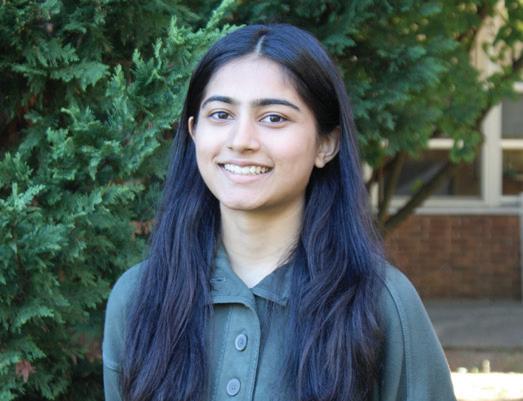

A future with no books. e destruction of knowledge. e loss of individuality. Ray Bradbury’s literary classic, “Fahrenheit 451,” experiments with this dystopian possibility, but we dare not think about the censorship of literature itself.
Unfortunately, we are no longer strangers to this unimaginable reality. PEN America found that between July 1, 2021 and March 31, 2022, there have been 1,586 book bans across 28 states. Accordion to NPR, aggressive campaigns to ban books in school curriculums and libraries have increased at an unprecedented level over the past two years, primarily spearheaded by conservative parent groups. e First Amendment Encyclopedia states that a banned book is one that is removed from a library or school curriculum, and students no longer have access in these places.
Many of the most commonly banned books — e Bluest Eye, Of Mice and Men or To Kill a Mockingbird, to name a few — are found in our own curriculum and primarily concern gender and racial identity. Nearby school districts, such as Great Valley School District and Central York School District, are facing battles between parents and administration on banned books. Such action calls into question the unsteady future of access to literature. Reading books from diverse perspectives forms an integral part of our learning experience and provides valuable insights from alternate perspectives. As other students face censorship around the nation, we too must advocate for an end to these conservative e orts.

Banning books wrongfully shields children from the ability to challenge conventional wisdom and educate themselves on new topics. Books make us more empathetic and open-minded, enabling
us to better connect with other perspectives and human experiences. Yet, book banners seem to fear this empathy brewing in students.
A school district in Texas temporarily banned “New Kid’’ by Jerry Cra , a book about Black middle-schoolers navigating through a private school with few students of color. Parents
the mental growth that allows us to question societal norms.
Removing books also does not make problems faced by marginalized groups disappear. As a society, we must be able to withstand the weight of dicult topics and uncomfortable conversations. Removing books that shed light on issues faced by
at said, parents understandably want to regulate the information their children are consuming and foster an environment conducive to their perception of the world. Parents o en want to create a skewed reality for their children. However, banning books based on individual need is not the solution.
Removing books from schools and libraries does not simply insulate children from alternate perspectives; it sends a message to the community that censorship is readily accepted and that we can slowly erase the history of certain groups of people.
Banning books is an act of fear — a fear of an unrecognizable yet inevitable future of new racial demographics and sexual orientations.
As students studying these books, we must be allowed access to form a nuanced comprehension of race, culture and gender.
argued it made white children feel like oppressors. Such claims restrict our capacity of empathy for others, making it possible to hate and fear people who resemble characters in books deemed inappropriate to read. Such actions limit discourse and stunt
marginalized groups
only brews ignorance. According to a report by PEN America, 41% of banned books explicitly address LGBTQ+ themes. We are le with an uninformed public, oblivious to the experiences faced by di erent communities.
As our peers are facing book bannings at an alarming rate, we must share how these books enrich our understanding of the world we live in today. Whether it is a discussion in the classroom or attending an anti-book banning protest we must combat these hurdles for us and future generations. Only then, can we stop the discrimination of people whose stories need to be told.
Leon Li/The SPOKE
From the Editor: The Best Teachers I Never Had
playground or the local library – and help to fix them.
Evan Lu Co-Editor-in-Chief
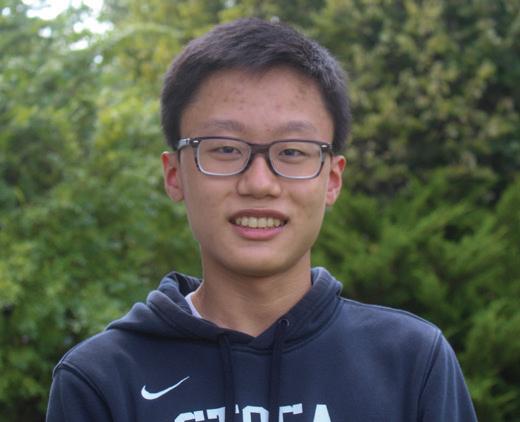
At rst glance, Phineas and Ferb is far removed from the genre of educational programming.
Or at least that’s what my parents thought. As a child, they rarely allowed me any screen time: “That TV will rot your mind Evan, just you wait!” Whenever they left me alone though, whenever I had a shot at unrestricted TV glory, I took it. And in a second act of defiance, I rejected the channels my parents did allow me to watch – PBS, BBC and the Discovery Channel – for something far more exciting: Phineas and Ferb.
As a wide-eyed 9-year-old, I watched all 129 episodes of the animated comedy series on Disney (a channel rarely associated with intellectually stimulating content). Yet in many ways, the show’s two main characters – 10-year-old stepbrothers Phineas Flynn and Ferb Fletcher – were the best teachers I never had.
Each episode encompassed another day of summer vacation, and Phineas and Ferb embarked on some grand new project. In the first episode, they built a backyard roller coaster. Another day, they invented cold fusion. Once, the pair constructed an escalator ascending to the moon. Each creation was crazier than the last, but nothing could stop them. Phineas was an incurable optimist, brilliant, creative and resilient. Ferb was cool under pressure, a quick thinker and a technological guru. Their faith in themselves was unwavering.
Phineas and Ferb showed me how science could be used to help people in everyday life.
Following their friend Isabella’s tonsil removal, they created the world’s biggest ice cream machine. When their sister Candace lost her phone, the pair made her a super-phone, complete with a rimshot app and teleportation system. They even built a “stratospheric ionizer” to wish a lonely Russian cosmonaut “Happy Birthday.” I saw them identify issues, figure out a plan and get to work. I began to understand how anyone could address individual problems – ones I encountered daily in school hallways, the park
I couldn’t stop imagining myself in their shoes. Before, creating change felt inaccessible. It was a task best left to adults, who were supposedly better-equipped and seemed to know what they were doing. The researchers, journalists and politicians on the news were decades older than me, sat in stiff suits behind great mahogany desks, and spoke with a reverberating tone of experience and gravitas. Yet here were two elementary schoolers, with bright messy hair and colorful shirts and voices that sounded just like mine, spotting problems in the world and doing something about them. Phineas and Ferb shared virtually nothing in common with the changemakers I knew – that is, nothing but a burning, unyielding passion for imparting an impact.
To this day, compared to the bourgeoisie elite of serious educational television, Phineas and Ferb are the supposedly “unsophisticated” and “uncultured” proletariat. It’s true: there are programs more suited to teaching, that can convey more knowledge in a shorter period. Yet while those are valuable, so are their light-hearted, comedic, cartoon cousins. It’s the shows that couple learning with fun that can pierce the hard shell of an unreceptive child, that can open their horizons and serve as a gateway to further education. And though I’d never dare to publicly contradict my parents on their screen time policies (Mom, please don’t read this), it was the clandestine episodes of Phineas and Ferb and not the History Channel that truly inspired my love for learning.

At some point I stopped following Phineas and Ferb’s adventures, and we each continued upon our own quests: the brothers with their legendary projects, and me with the complexities of growing up and my reinforced passion for impact. Phineas and Ferb dared me to dream big, have faith and realize that anyone could make a change in the world through science, government education or something di erent altogether.
So to the parents, don’t be afraid to let your children indulge sometimes. To my fellow high schoolers, don’t be embarrassed or ashamed to enjoy a childhood classic. And to the younger generation, don’t blame Evan if you get caught watching Dr. Doofenshmirtz and Perry the Platypus during homework time.
OPINION ursday, October 20, 2022
The Sta www.spoke.news @thespoke @thespoke /thespoke the_spoke hello@spoke.news Editors-in-Chief: Evan Lu, Hiba Samdani Managing Editor: Jui Bhatia News Editor : Ben Shapiro T/E Life Editor: Abby Bagby Opinion Editor: Shreya Vaidhyanathan Sports Editors: Howard Kim, Hannah Simon Beats Editor : Maya Shah Multimedia Editors: Katherine Emmanuel, Grace Kuryan Webmasters : Rohan Anne, Soumya Sathyanarayana Business Manager: Michael Tierney Photography Editor: George Zhang Social Media Editor : Akshita Joshi Copy Editor: Zara Samdani Design Editors: Aren Framil, Raima Saha Cartoonists: Angie Chen, Leon Li, Yuting Pu Sta Reporters : Prashi Agarwal, Tanisha Agrawal, Angel Antoneyp illai, Miya Cao, Alexander Carder, Vanessa Chen, Weihan Chen, Mareska Chettiar, Rowan Chetty, Abigail Chong, Ryan Ding, Isabelle Emmanuel, Saktisri Gowrishankar, Joanna Harris, Julia Harris, Je rey Heng, Evangeline Kennedy, Audrey Kim, Bailey Kreszswick, Soumya Krishna, Shrija Krishnan, Lexi Lin, Amanda Markind, Margaret Neary, Riddima Pandey, Lauren Pinheiro, Abbie Preston, Madeline Pulliam, Louisa Sandor , Emily Scheer, Sousanna Sengal, Aashita Singh, Eshan Singh, Vaishnavi Sriadibhatla, Elizabeth Sun, Remington Vaughan, Alexa Willrich, Juliana Yao, Faith Zantua Faculty Advisers : Laura Howard, Alison Ferriola, Nicole Zakorchemny Non-sta contributions: Non-sta contributions from students, the community, graduates or other interested parties are welcome. Editors will decide which contributions are published based on space and relevance to the community. All contributions must conform to journalistic practices, including accuracy, timeliness, purpose and writing conventions. The Spoke reserves the right to work with the contributor to meet these standards. All outside contributions are bylined. Letters to the editor: Letters to the editor may be submitted to Editors-in-Chief Evan Lu and Hiba Samdani, or advisers Cyndi Crothers-Hyatt, Alison Ferriola and Nicole Zakorchemny. Editorials: Unsigned editorials represent the views of The Spoke editorial board, not necessarily those of the administration, student body, community or advertisers. The opinions expressed in signed columns are those of the writer and not necessarily the opinion of The Spoke. Paid advertisements: The Spoke accepts paid advertisements. Email hello@spoke.news. The Spoke is published seven times a year by Trumbull Printing. It consistently receives a Gold rating from PSPA and CSPA, and is a National Scholastic Press Association Pacemaker award-winning publication. The Spoke serves as a public forum for student expression.
the haunted house world. Whether you choose the classic Eastern State Penitentiary or go for the Bates Motel
Pumpkin carving competition
Now that you are old enough to handle a knife without your parents standing over your
Angie Chen/The SPOKE
Yuting Pu/The SPOKE
Angie Chen
/The
SPOKE
My first interaction with a Master of the Tangent was in 5th grade. I don’t remember most of my 5th grade teachers, but I couldn’t forget Ms. Crocker if I tried. She was my math teacher, a tall woman with wispy gray hair and a fiery attitude. The reason I remember Ms. Crocker isn’t because of her teaching ability — sure, she was good at helping students understand material, but not significantly better than any other teacher. Nay, Ms. Crocker was memorable for her legendary tangents.

And oh, what tangents they were! Once, she broke into a tale of witnessing a gust of wind blow an old lady into a puddle in Chicago. Another time, class began with a lesson on distance equations and ended with a long rant on the
Getting off track, going on tangents
excessive amount of air in Dorito bags.
As I rose through the ranks of middle school and then high school, I noticed that the best teachers liberally seasoned their classes with tangents. One yakked about her cats and gabbed about Fig Newton commercials. Another jumped from a review of the previous night’s homework to a discussion of personal experiences with roadkill (deer, ducks, beavers, and more: you name it, a mom driving to Walmart killed it). Yet another teacher spontaneously launched into an extensive account of his life story, complete with drug violence and South Philly accents.
Those times in class when the lesson swerved (never by design) into some esoteric idea, random conception, or half-baked thought were
always my favorite. There is something deeply liberating about ignoring the predetermined lesson plan and enjoying a laidback sidetrack, like a child might feel while stealthily swiping a snack from the cookie jar. Yet some
from teaching. Tangents have no measurable benefit or obvious connection to course content. Tangents are a waste of time. Period.
But do tangents truly hold no purpose? The answer depends on one’s approach to




STUDENTS SPEAK OUT




teachers are vehemently opposed to tangents. We all know this person: when they see the class making for the abyss of tangential discussion, they seize the joystick and yank the discussion back on course. To them, tangents serve no purpose. Tangents derail the agenda and detract
teaching. If your goal is to satisfy an agenda, then forget about tangents. But, if your goal is to build a space where students leave at the end of each day yearning to come back tomorrow, the tangent serves a much higher purpose. The effects are staggering. Oftentimes, tangents
give students–and teachers–a much-needed break from the regularly scheduled programming of school, brightening their day and minds. Tangents create class bonds, engage students in conversation and argument, and encourage participation. Teachers can allow their humanity to shine through, showcasing their sense of humor and facets of their personalities that are usually tucked away. The ultimate purpose of education is to inspire intrinsic motivation and intellectual curiosity. To this end, tangents are some of the most powerful weapons in the educator arsenal. Period.
There’s a reason that few teachers have mastered the art of the tangent. Just as other arts like archery and carpentry, “tangentry” requires a refined touch that comes only from practice (without fail, the tangent black belts
are always the more experienced educators). To make it worse, the effect of a tangent is indefinable. The effect is intangible. The effect is unmeasurable by any traditional metric. Indeed, the best metric for measuring a tangent’s effect is not test scores or grades, but through close observation. Boston Philharmonic Orchestra conductor Benjamin Zander puts it best: “I realized that my job was to awaken possibility in other people. You know how you find out if you’re doing that? You look at their eyes. If their eyes are shining, you know you’re doing it.” This lesson applies to teachers and students just as it does to conductors and musicians, or coaches and athletes, or parents and children. The tangent is not just fun and memorable, but useful and impactful.
Plans and agendas still deserve a spot on the lineup, but the tangent is a varsity player too. So, if you’re a teacher, try something new; the next time your class is veering off track into the world of tangents, embrace the unknown and dive headfirst into the breach. And don’t forget to watch their eyes.
Report Card

 SNL’s New Season
SNL’s New Season
+ SO good every time, SNL never disappoints - felt like it went by way too quickly
A








Q: How have testing days affected you so far this year?


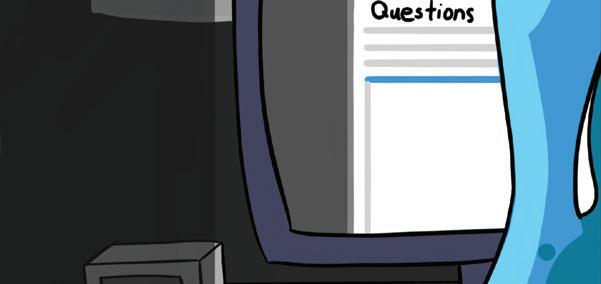


Here to stay!
to better organize their time and more e ectively make use of it.
Testing Days
fullest potential in other classes, creating a less e ective use of class time.
Everyone understands the frantic scramble that is test day. Whether you are rushing to review ashcards, reading through your notes, or having a friend quiz you, there never seems to be enough time to prepare. Luckily, with the continued implementation of assessment days, students can no longer have as many assessments on a single day. Although the policy was originally implemented last school year, department-based assessment days have seen stricter enforcement into the 2022-2023 school year. Currently, world language and English test on days one and four, math and electives on days two and ve, and social studies and science on days three and six. is dispersal of testing not only reduces stress but also allows students
As assessments become more spread out, students can prioritize studying for ones that occur earlier. is can help improve time management, a vital skill to develop regarding study habits. As recommended by Purdue University in their tips for better time management, although it may be a di cult skill to master, focusing on one thing at a time helps improve overall studying e ciency. Instead of studying for three assessments
at the same time, students can now dedicate more time to each class.
Testing for too long in a day can also contribute to a sense of mental fatigue. A study by the American Psychological Association found that a er students participated in testing for three or more hours, they reported unusually high levels of fatigue. While this may not have a negative e ect on test scores, it can impair a student’s ability to learn for the rest of the day. As a result, students will not be achieving their
Some argue that by extending the period of time over which students have assessments, stress is simultaneously prolonged. However, this prolonged time period is precisely the bene t of implementing testing days in the rst place. While students may still feel stressed, testing on di erent days guarantees all the stress will not accumulate in a single day, which can be overwhelming. According to the Mayo Clinic, spreading out your work and studying is a recommended way to reduce test anxiety and stress, stating, “It’s much better to study a little bit over time than cramming your studying all at once.” With assessments spread over multiple days, students do not have to cram for their tests in one night, alleviating this pressure.
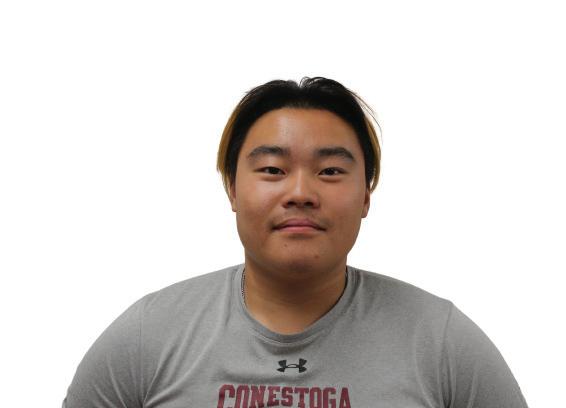
In order for testing days to have the desired e ect, it is essential that we adhere to the dates and guidelines provided by the school district. If only some teachers follow the test schedule, it could result in students having even more assessments within one day. While there may be certain days where it seems ine ective, we all must work together to ensure that testing days achieve their full potential.
Responding to students’ cries for help in the tsunami of academic assessments, the administration has provided a imsy pool noodle: testing days. To prevent the inevitable stress of taking multiple tests in a single day, the school instituted a new policy in which departments can test exclusively on two assigned days per cycle. In an attempt to reduce stress, the school has unintentionally complicated the academic agenda for both students and teachers.
As the system was primarily designed for students, teachers are le out of the equation. Teachers are sometimes forced to test a week a er the unit ends, leaving a gap where teachers must adjust their schedules. Especially in AP classes — whose tests are scheduled on a set date — such an extended period of time cannot be a orded to continuously review material. erefore, teachers move onto new information, forcing students to balance both old and new in-
formation - a task that quickly becomes stressful for multiple classes. is studying method may not even be e ective: a 2015 study done by Vanderbilt University found that students who tested a week later a er studying material retained less information than those who were tested immediately a erwards. Such a nding renders large gaps between review days and test days ine ective for overall performance. A xed date gives a teacher less exibility to adjust their teaching pace to student feed-
Ben Bernanki Nobel Prize Phillies advanced to the playoffs
B-
+ influenced tons of monetary policy during the 2008 housing crisis - overshadowed the other winners with his previous fame
+ made it for the first time since 2011 - did not perform as well as people thought they would
Jeffery Dahmer Netflix special
- insensitive to victims’ families for romanticizing his actions - genuinely too creepy to watch all the way through
Tory Lanez ‘Sorry 4 What’
+ super cohesive, very few weaker songs - come to Philadelphia, Tory!
Don’t Worry Darling drama
+ it was honestly really entertainig
- feels staged for movie publicity
BeReal
+ you can see what your friends are doing all at the same time

- built on the basis of authenticity but feels fake
Time to go!
F B
back. Any process that alienates student progress from classroom teaching style is detrimental to classroom cohesion.
Furthermore, the academic balancing act actually impedes students from planning their studying properly. Many students are now nding weeks in which they have a

test every day. Students are nding themselves in a situation akin to having to take multiple AP tests in the rst week of May. Back-to-back testing leads to burnout, induce poor sleep habits and diminishes return on academic performance. is exhaustion is what the administration was trying to prevent when they rst implemented testing days. According to the American Psychological Association (APA), students o en undergo testing fatigue a er an extended period of time testing. However, mental fatigue is falsely credited to lower test scores and poor performance. A study conducted by the APA found that students who took longer tests scored signi cantly higher on a standard SAT test, despite feeling mentally drained. While students may admittedly feel tired a er a long day of testing, their performance isn’t compromised. While the administration is attempting to help students, testing days don’t address the root problem behind this new system - the stress of too many tests, projects and assessments. Even with days designated to certain subjects, having a lot of tests can be overwhelming. When it comes to student mental-health, testing days are a misguided, temporary treatment, not a permanent cure.
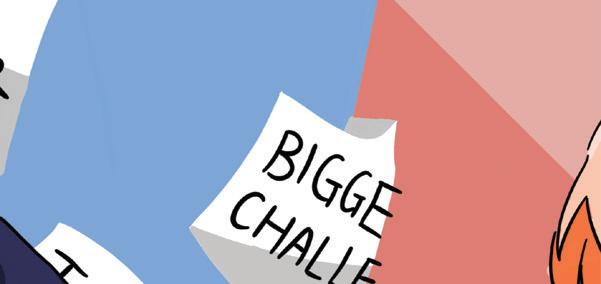
9ursday, October 20, 2022 OP/ED
Leon Li/The SPOKE
C+
AA-
Maya Shah Beats Editor
Hiba Samdani Co-Editor-in-Chief
Leon Li/The SPOKE
“I haven’t really had many tests yet, but it’s not too di erent from last year; things have been going pretty smoothly for me.”
“For students like me who like to specialize in certain subjects, I have so many tests in one day that some times it just becomes overwhelming.”
Alex Gardiner, freshman
Basil Lubiniecki, junior
Sam Wang, senior
Karen Hang, sophomore
“I’ve
honestly
felt no e ect from testing days. Some times I may have a test or two that stack on the same day, but other than that it’s not really any change of pace from last year.”
“It
does make the timing of the lessons kind
of
awkward because you nish
the
lesson
and
you’re not able
to
do
the
test right away.” Yuting Pu/The SPOKE
Angie
Chen/The SPOKE
Evan Lu
Co-Editor-in-Chief Days 1 + 4 Days 3 + 6 Days 2 + 5 World Languag e English Electives Math: algebra 2 ab math: ap calculus bc social studies: positive psy cholo gy science: honors chemistr ysocial studies science
Keeping up with the currents: Siblings bond over crew
Howard Kim Co-Sports Editor
When she walked into her rst crew meeting in her middle school’s cafeteria six years ago, Savanna Jacovini had no idea that she was taking her rst steps into a sport that would soon come to transform her siblings’ lives and their relationships with one another.
Over the last six years, Jacovini and her two siblings would all compete in the crew program and fall in love with it.

Jacovini joined the Conestoga Crew club during her freshman year of high school with no prior experience or knowledge about rowing. She had never quite found her footing in any other sports prior to high school and was searching for a fresh start somewhere. One of the main reasons she joined was because she loved the idea of starting a sport where everyone would be a novice just like her. Upon joining, she quickly fell in love with its clean slate and unique qualities.
“It (Crew) wasn’t like soccer where you try out for the rst time your freshman year, and there are girls that have been practicing since they were 5 years old. It was cool to nd a sport that I could really sink my teeth into,” Jacovini said.
is enduring passion for rowing has always been her driving reason for pushing herself to test her limits as both an athlete and leader on the water. During her time in crew, Savanna quickly excelled



in numerous competitions not only through her athleticism, but also her dedicated leadership and aptitude for nurturing younger athletes.
“You could tell that everything she did was with a very genuine heart and that she was always helping teammates with their issues, whether they were medical, mental or emotional.
She was a great leader in all aspects,” Goldia Kiteck, Conestoga Crew club’s head coach, said.
Similarly to their older sister, Savanna’s two younger siblings, Willow and Peter Jacovini both signed up for crew when they entered high school. However, each athlete’s personal journey was di erent. Willow was undecided on signing up, so she tried it out during a beginner event run by the crew club. Afterwards, she decided that she enjoyed it and joined her sister.
On the other hand, Peter had always been against following in his sisters’ footsteps throughout middle school, but as high school grew closer, he saw how much joy it brought Savanna and Willow and was persuaded to join them. Because all three siblings play the same sport, it strengthened their familial bonds and friendships with each other.
“I feel that in my family, (crew has) become part of our identity since me and both of my older sisters have rowed for all of our years of high school so far,” Peter Jacovini said. “I couldn’t imagine what we would talk about if none of us were rowers.”
Soaring to new heights: Eagles enjoy successful start to season
moves included dra ing Jordan Davis in the rst round and Nakobe Dean in the third round.
It is starting to look like 2018 again. e window is now open for the Philadelphia Eagles to make another Super Bowl run and bring home the Vince Lombardi Trophy for the second time in ve years.
Yes, I know. Proclaiming that the Eagles will win it all is a bold statement, especially with the team’s performance last year. But thanks to general manager Howie Roseman, the players have a legitimate shot this year.
Despite his mistakes in the past, Roseman proved himself tremendously this o season by bolstering the team and lling holes where its weaknesses were. Starting o with the defense, Roseman signed linebacker Haason Reddick, who was a much needed acquisition. He also signed pro-bowler cornerback James Bradberry who locked up receivers with Darius Slay. Other
Davis is an absolute monstrosity of a player: He is 6 feet 6 inches tall and weighs 335 pounds. Dean is also considered the best pick of the dra because he was a rst-round talent selected in the third round.
Roseman has also improved the o ense signi cantly. One of his most notable moves was trading a rst-round pick for star receiver A.J. Brown. Brown is arguably the best receiver the Eagles have had in the last decade and pairs well with fellow Eagles receiver DeVonta Smith. Prior to the trade, Brown put up impressive numbers in Tennessee.


ese o season acquisitions clearly made their mark as the Eagles started o the season undefeated with a 5-0 record and the No. 1 spot on the NFL power rankings. e Eagles have almost everything in place for them to make
a Super Bowl run; only one thing remains: the reliability of quarterback Jalen Hurts.
Last year, Hurts was a mediocre passer at best, throwing 16 touchdowns and nine interceptions. He also had questionable decision making, missing out on many good opportunities to convert. is led many fans to question whether Hurts could keep up with this newly upgraded team, which marked this year as a make or break year for him. Five games in, he seems to be doing an amazing job making notable improvements in his decision-making and passing accuracy.
Many fans, myself included, were unsure of whether the Eagles would live up to the hype or not. But a er their performance in the rst ve weeks, I believe that the birds will have a legitimate chance of making a deep playo run. Maybe we will even get another parade on Broad Street.
Trust: in oneself, in your teammates and in the ball. An integral part of their mission, the girls’ varsity tennis team has begun the 2022 season on a high note, nishing the regular season at 11-0. Led by head coach Britt Aimone, the team is now in pursuit of more, with fond memories of last year’s state championship driving them and team culture being the number one priority.

“For me it’s all about the sisterhood that these girls embody. Watching these girls really come out of their shell and express themselves is way more important to me than any win,” Aimone said.
Last year, the team finished with a 22-0 record, winning the Central League Championships, district championships and state championships. United as a whole, senior captain Coco Lucarelli recognizes the effort put into last season’s success.
“Last year was amazing,” Lucarelli said. “Coming into the 2022 season, we (the team) knew there was a lot of work to be done, but we’re more determined and inspired than ever.”
Following in suit, Kate and Isabelle Emmanuel won the Central League Doubles Championship, Bella Chen and Jennifer He were runners up, and all four are slated to participate in the District Doubles Championship, feats accomplished as a result of overall team solidarity.
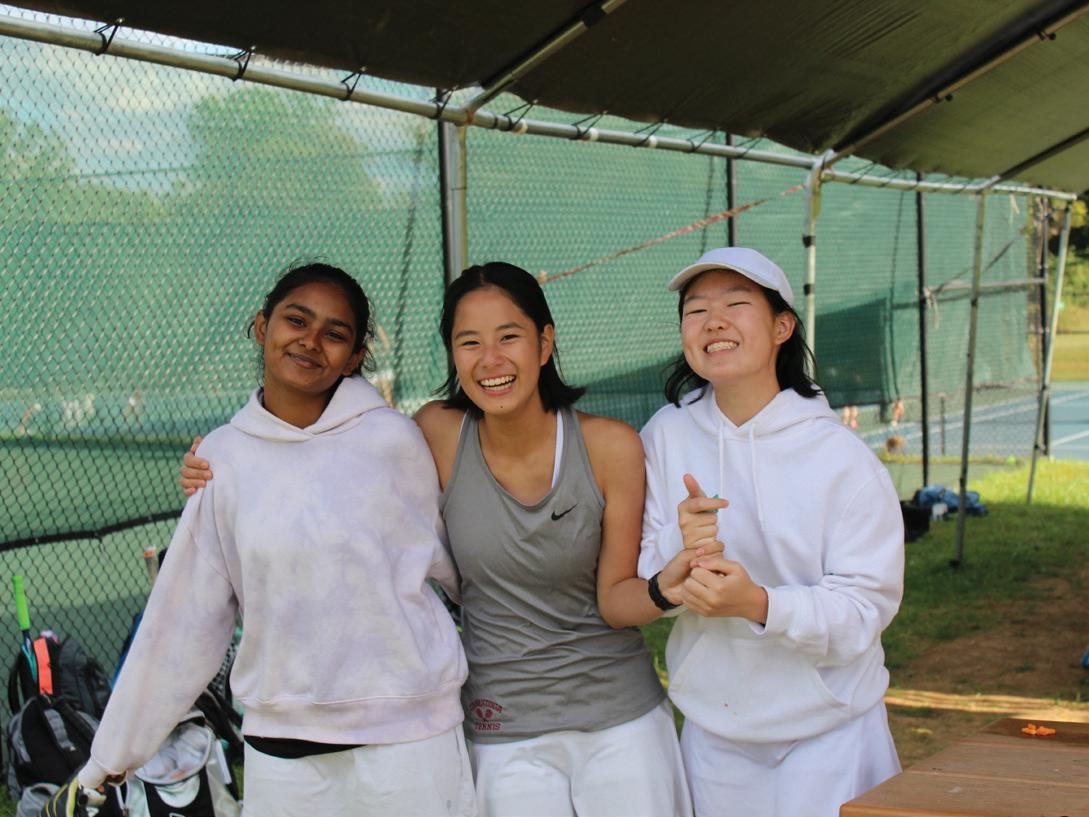
“On our team, everyone is viewed as equal,” Aimone said. “Achieving personal excellence as opposed to victories is a mindset I feel will give the best opportunity to succeed on and o the court.”
While the team boasts immense talent, the players continue to grow every single day under the parameters of kindness and sportsmanship. A family at heart, the girls become sisters in a short time and build bonds that last a lifetime. Presence amongst one another is also mandatory and is readily ac-
knowledged by the girls as a key cultivator of their success.
“My favorite part about being on the team is the people,” Lucarelli said. “I especially love our pasta and pool parties.”
Every year is a clean slate, and while progressing to the state championship continues to be a goal, coach Aimone expects her team to rst and foremost carry on the team culture,
make lifelong memories and have fun.
“We don’t look too far into the future,” Aimone said. “I believe it’s important to be present in every match surrounded by our family.”
CornerCommitment Corner
Commitment
Kenzie Clement MCDANIEL COLLEGE

SPORT: SOCCER GRADE: 12


Why McDaniel: “I chose McDaniel College because it offered a wide range of academic opportunities as well as a great soccer program. I love the traditions there like tailgating on The Hill and a smaller college environment. Overall, McDaniel had everything I was looking for in a college atmosphere.”

 Girls tennis repeats as Central League champions
Girls tennis repeats as Central League champions
Sports
10 ursday, October 20, 2022
Pulling ahead: Conestoga alumna Savanna Jacovini and her teammates launch their boat in Sarasota, Florida to compete in the National Team Trials. They were selected to represent the U.S. at the 2022 World Rowing Under 23 Championships, but Jacovini could not due to an injury. She will continue her crew career during her sophomore year at Boston University.
Courtesy Aaron Preetam
Aren Framil/The SPOKE
Hannah Simon Co-Sports Editor
George Zhang Photography Editor
Tennis trio: Senior Yasthika Ashokkumar and sophomores Rebecca Wang and Lauren Wu enjoy time together during a match. The players forged strong bonds and became a family this season.
Miya
Cao/The SPOKE
Swinging to score: Junior Kerry Harley returns a volley during a match for the JV girls’ tennis team at the Upper Main Line YMCA. The team has remained undefeated throughout this season.
Rowan Chetty/The SPOKE
Breaking barriers: Male sophomore joins cheer team

Friday night lights — the excitement of the football team’s enduring success nip ping at the student section, the band belting out the har monies of Encanto and the long-lasting popularity of the concession stands — now has just one more thing for fans to cheer on.
Sporting a white polo shirt and gray sweatpants, sopho more Henry Barnes can now be seen hoisting girls up into back-breaking stunts and wav ing pom poms amongst the formerly all-female squad. After hearing a classmate talk about the team in biology class, Barnes reminisced on his past years in competitive cheer and decided to return to cheerlead ing after a two year hiatus.
“They (tryouts) were in timidating, not in a bad way, just more in the way that there’s a bunch of kids there that didn’t know (if) they’re gonna make it,” Barnes said. “It was fun though. Everyone was very accepting.”

An avid tumbler with a background in gymnastics, Barnes began cheering com petitively at age 8. Eventually qualifying for the Cheerlead ing Worlds Championship in Orlando, Florida, Barnes accumulated a remarkable passion for the sport. Cheer leading, while not popular
amongst men, combines high energy components with a de tailed precision in a fast-paced environment — one that Barnes thrived in and loved.
“To me, it’s always been normal. Whenever I did com petitive cheer, there were al ways four or five other guys on the team,” Barnes said.
Barnes inevitably stood out among the cheerleaders. Not only because he is the only boy who has been a part of the or ganization in decades, but be cause of his bright, contagious personality and fearlessness in everything he does, according to Montgomery.
“We were so excited because we’ve never had a boy on the team. And having Henry for the first time this year is so ex citing, especially because he’s so talented,” said senior cap tain Ellie Montgomery. “We were crossing our fingers hop ing he would make the team.”
Despite his credentials, Barnes’ membership received particular attention from the coach and captains. Because the team is accustomed to girls, there were concerns about how the sophomore would acclimate to the team’s and the communi ty’s reaction. Not one to shy away from an opportunity like this, Barnes participates as much as possible in routines and events, garnering the attention and ado ration of the community.
“We (the captains and coach) told (Barnes) from the

beginning if you’re ever un comfortable with anything at all, change it — do whatever you need to do to feel com fortable,” Montgomery said.
His technique managed to catapult Barnes’ role within the team, with his strength maximizing the difficul ty level of routines and his knowledge allowing him to
command any dance series. Besides tumbling, he primari ly works as a back spot behind the stunt, ensuring the flyer does not fall.
“Conestoga has always been known as a really clean team. We’re always very sharp and to gether,” Montgomery said. “Now having Henry just adds that aspect of ‘Wow, that was really cool.’”
The addition of a male mem ber will understandably distin guish the squad from its rivals, and if he makes the winter com petition team, he will help the squad stand out. No matter his role from cartwheeler to back spot, it is clear that Barnes has become a key member of the team who his teammates have grown to love.
11Sports
Plenty of pep: Sophomore Henry Barnes performs a backflip in front of the cheerleading team at the Blackout football game on Oct. 8. He began competitive cheerleading when he was 8 years old and returned to the sport this year after a two-year break.
Hannah Thorne/The SPOKE
Hannah Simon Co-Sports Editor
Thursday, October 20, 2022
New nonprofit sports club supports field hockey team
As the sounds of field hockey sticks clashing and cleats scything the turf field wash across the Berwyn Sports Club, this new facility is taking the local sports community by storm and avidly supporting the field hockey team.

John Bickel, a former lacrosse player, former high school coach and current club lacrosse director of Team Ten, developed and built BSC. The new field hockey and lacrosse club is a private, non-profit facility located a few minutes from Conestoga down Cassatt Road. Construction started in April 2021 and finished this past spring. The ten-acre facility was designed for field hockey and lacrosse training
and is currently providing the girls’ field hockey team with a vitally important place to practice two days a week.
The field hockey team is off to a strong start with 13 wins and one loss so far this season, reaching the second half of their season at the top of the Central League. Karen Gately, assistant coach of the team, has welcomed BSC with open arms and recognizes its benefits.
“The facility is brand new and is beautiful. It’s really nice because when it rains, we have the flexibility of going inside because they have an AstroTurf field inside,” Gately said.
“It’s beautiful.”
e team usually practices at BSC every Monday and Wednesday. Co-captain Lily Norton is thankful for the facility and how it has boosted team morale.
“I’m just grateful that we get a place to practice that has field hockey lines and a turf field. Driving the underclassmen to practice after school has also helped with team bonding because I can talk to girls who I normally wouldn’t,” Norton said.
According to Gately, the only difficulty of practicing at BSC is the transportation aspect. It is not safe to walk to the facility due to the lack of sidewalks, and it’s up to players to carpool to make sure all the girls successfully get to practice. This requires a great amount of coordination, so no players or equipment are left behind. Despite this, the girls are thankful for this state-ofthe-art training facility.
“The players at times will miss practicing at Teamer
just because that’s our home field. But again, I think they’re mostly excited about the fact that we’re assured an appropriate playing surface for every practice. That’s the biggest thing,” Gately said.
In addition to Conestoga Field Hockey, Bickel anticipates having other local teams practice at BSC in order to help more athletes pursue their goals. Bickel used to coach Conestoga’s boys’ lacrosse team and he now runs the youth lacrosse program, Team Ten.
“I support athletes. I’m a big proponent of athletes,” Bickel said. “We saw a demand and a need for a home base for the program and other athletes. For me, athletics was a big part of my upbringing, and I attributed it to life and learn-
ing life lessons. This is a great place to attack your dreams and that’s why we put it here.” is is just the beginning for BSC. Bickel has an optimistic outlook on the facility and believes it will have a strong impact on the local community and sports teams.
“I think BSC is just a great place for kids to go and learn that you have to work for and earn what you want,” Bickel said. “If you want to become a better player, you have to work at it. Athletics for me was always something I was drawn to and passionate about, and that’s what drove me to create BSC. We’re a training facility that kids can call their home base. A place where kids can come and be proud of their hard work and attack their dreams.”
Full circle: ’Stoga alumna returns to coach JVA girls’ soccer team
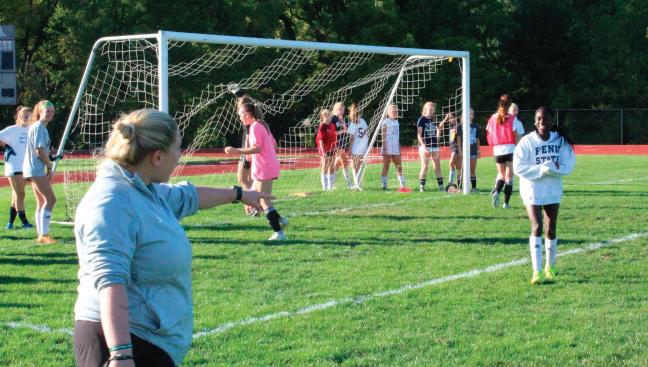
Supervising the JVA girls’ soccer team as they scurry across the eld is a familiar face. Five years prior, she was one of these players.
Ariel Loevy graduated from Conestoga in 2018 a er playing on the soccer team in high school. She then committed to Denison University in Ohio to continue her soccer career. High school soccer remained memorable for Loevy, and a er graduating from college in the Class of 2022, she returned as the JVA girls’ soccer team head coach.
“I loved it (’Stoga soccer). It was one of my favorite soccer experiences,” Loevy said. “I had a great team and great coaches. I learned a lot about myself as a player, and it showed me that I wanted to play in college too.”
Loevy decided to attend Denison for its small size, academically challenging programs and soccer team. She took advantage of the university’s strong science department, majoring in biology to pursue nursing.
“Just going onto campus I fell in love with (Denison University). I met the soccer team when I was in high school, and they were awesome. ey were super cool and just made me feel really welcomed,” Loevy said.
Coaching came out of le eld for Loevy. She had not considered it until Katie Wilson, English teacher and JVB soccer coach, encouraged Loevy to be the head coach of JVA girls soccer. Wilson had coached Loevy when she was on the JVB team and understood her dedicated nature.
“ e JVA program deserves someone who is a erce competitor but who also knows how to foster character among players,” Wilson said. “I think (Loevy) will be excellent in that sense.”
For Loevy, being an alum and a coach has allowed her to connect with the athletes. Having been a player herself, she acknowledges how tired the athletes are a er long school days and how they want to relax and have fun.
“Being able to reel them back in and say, ‘this is what we need to work on,’ is challenging,” Lo-
evy said. “But seeing their growth throughout the season makes it super worth it.”
Additionally, Loevy is able to talk to her players about the similarities in the school, such as the teachers that they shared. She believes this brings her closer to her players. Loevy also witnesses the differences in how the school is now compared to when she attended.
“It’s a lot of fun being back and being able to see how the school changed and what the students and the teachers are like now. I’m just really happy that I’m able to do it,” Loevy said.
Whether Loevy will continue to coach next year is still undecided. She currently works at the Children’s Hospital of Philadelphia and plans to enter nursing school, which would tighten her schedule. For now, she is trying her best to push her players.
“She comes across as tough,” Wilson said. “But she’s as loyal as they come and will support everyone in her life to the end of the earth.”
e SPOKE ursday, October 20, 2022
New surroundings: JVA co-head coach Jean Allen watches her eld hockey players warm up on the turf eld in the Berwyn Sports Club. The team began using the space this year as a practice facility. Berwyn Sports Club’s owner John Bickel will be using the space for Team Ten Lacrosse’s practices in the future.
Opinion: the Eagles’ newfound success
Page 10
Recap of the Phillies’ stellar season
Page 11 New
addition to the cheerleading team
Page 11 Commitment Corner Page 10
Howard Kim/The SPOKE
Juliana Yao/The SPOKE
SCORELINE W L T scores as of 10/10
Field Hockey
Football
Volleyball
G TennisG Soccer B XCB Soccer G XC G Golf 5 2 0 12 1 0 5 2 0 5 9 0 10 1 0 9 2 0 13 0 0 11 1 1 12 1 0 B Golf 9 2 0
Astute advice: Head coach Ariel Loevy instructs members of the JVA girls’ soccer team during a practice at the grass elds near the track. She has focused on connecting with her players and cultivating a positive team environment.
Juliana Yao Sta Reporter
Michael Tierney Business Manager

 Shreya Vaidhyanathan and George Zhang, Co-Webmaster, Opinion Editor and Photography Editor
Shreya Vaidhyanathan and George Zhang, Co-Webmaster, Opinion Editor and Photography Editor














 Tanisha Agrawal Sta Reporter
Tanisha Agrawal Sta Reporter












 WRITTEN BY AREN FRAMIL, CO-DESIGN EDITOR
WRITTEN BY AREN FRAMIL, CO-DESIGN EDITOR














 Abby Bagby T/E
Abby Bagby T/E





























































 SNL’s New Season
SNL’s New Season


























 Girls tennis repeats as Central League champions
Girls tennis repeats as Central League champions




